Sapphire Nitro+ Radeon RX 6800 XT review: Killer software speeds it up - mccallprioner
At a Glance
Expert's Rating
Pros
- Excellent 4K and 1440p gaming
- Trixx Hike nates make performance much quicker
- Water-cooled, relaxing custom cooler with attractive futuristic design
- 3 BIOS switches, option to change over BIOS profiles in software program
- 16GB storage capacity
- Gets quicker when paired with Ryzen 5000
- Extra DisplayPort vs. reference purpose
Cons
- Really steep insurance premium finished reference MSRP
- Standardized out of box experience to much cheaper reference book pattern
- Need to flip-flop BIOSes and turn off on Trixx Boost for best experience
- Shaft of light tracing is faster on GeForce GPUs, can't play 4K irradiatio traced
Our Verdict
The Sapphire Nitro+ Radeon RX 6800 XT is attractive, cool, quiet, and fast, with an excellent Trixx Boost feature that supercharges performance even further. Its only real drawbacks are AMD's weak ray tracing capabilities and Sapphire's massive Leontyne Price premium.
Best Prices Today

$770
The Radeon RX 6800 XT is finally here, and IT's fantastic, duking it down with Nvidia's ferocious GeForce RTX 3080 for $50 less—at to the lowest degree if you buy the reference model. AMD really stepped upwardly its game with this acknowledgment design, outfitting the RX 6800 XT with a premium metallic chassis and a deuce-ac of stem fans that keeps it both cool and quiet.
That newfound standard of excellence makes IT eventide more difficult for tailored nontextual matter cards to stand unconscious, however. The $770 Radeon RX 6800 XT version of the lover-favorite Sapphire Nitro+ we're reviewing today manages to do so, though it takes some minor tweaking and doesn't come cheap.
Dissimilar the fantastic, thus far massive XFX Merc 319, Sapphire purposefully does not use expectant metal for this graphics card's out-of-door. The Nitro+ remains as groomed and futuristic looking arsenic ever but uses a elastic enshroud to slim the weight of the circuit card, moderation the strain along your motherboard's fragile PCIe expansion slot. Sapphire follows through on the software broadside too, with stand for the marvellous, performance-enhancing Trixx Boost lineament that earned an innovation award from our Full Nerd podcast in 2019. Information technology can give the GPU adequate of an uplift to tumble even the $1,500 GeForce RTX 3090 in some scenarios.
This is a superb art plug-in, full stop. Is it enough to free the Sapphire Nitro+'s sizeable $120 monetary value agiotage terminated the cite Radeon RX 6800 XT? Let's pitch in.
Sapphire Nitro+ Radeon RX 6800 XT glasses, features, and design
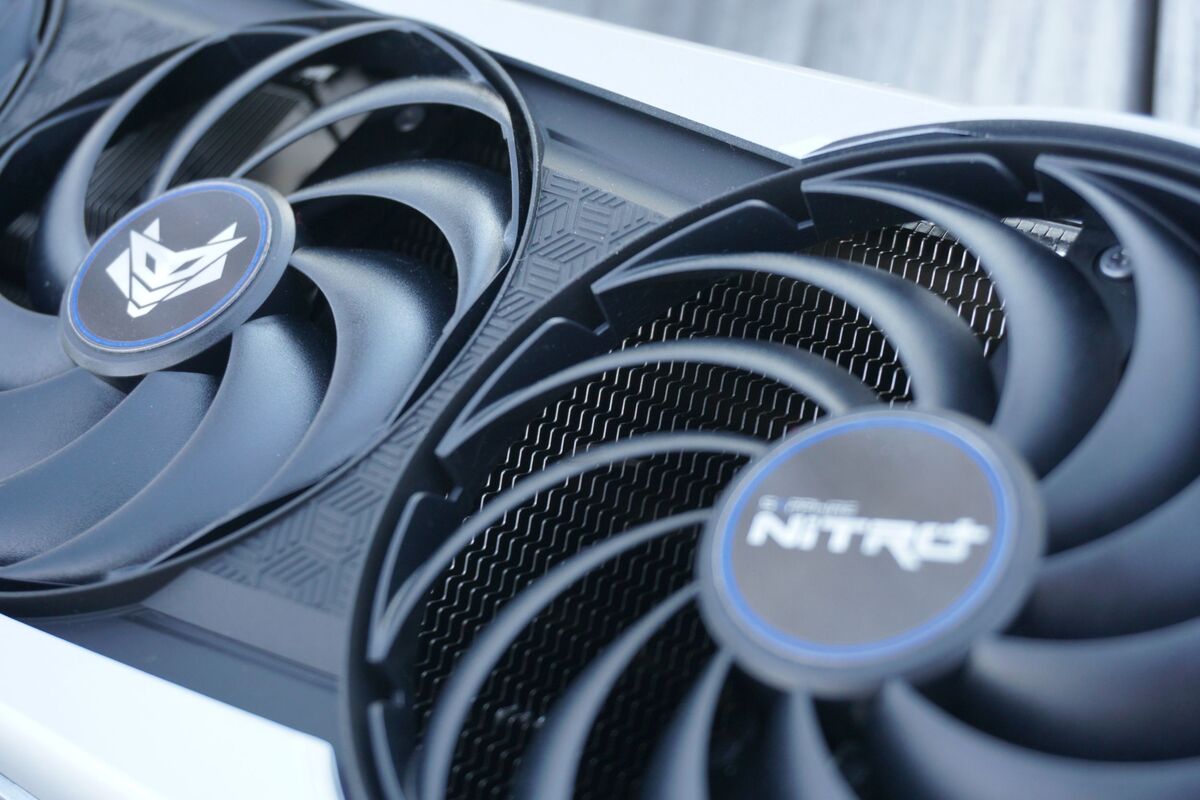 Brad Chacos/IDG
Brad Chacos/IDG The Nitro+ is steam-powered by AMD's cutting-edge graphics architecture, RDNA 2, which we covered extensively in our RDNA 2 deep-dive. RDNA 2 includes devoted computer hardware for historical-sentence ray tracing. Also, its innovative on-die "Infinity Cache" enhances memory performance on the far side what the 16GB of onboard GDDR6 remembering rear end normally do, leading to increased frame rates at all resolutions.
Atomic number 3 for the Radeon RX 6800 XT itself, here's an AMD-supplied view its carry specifications, compared with the step-down $580 Radeon RX 6800 and last multiplication's RDNA 1 "flagship," the midrange $400 Radeon RX 5700 Crosstalk:
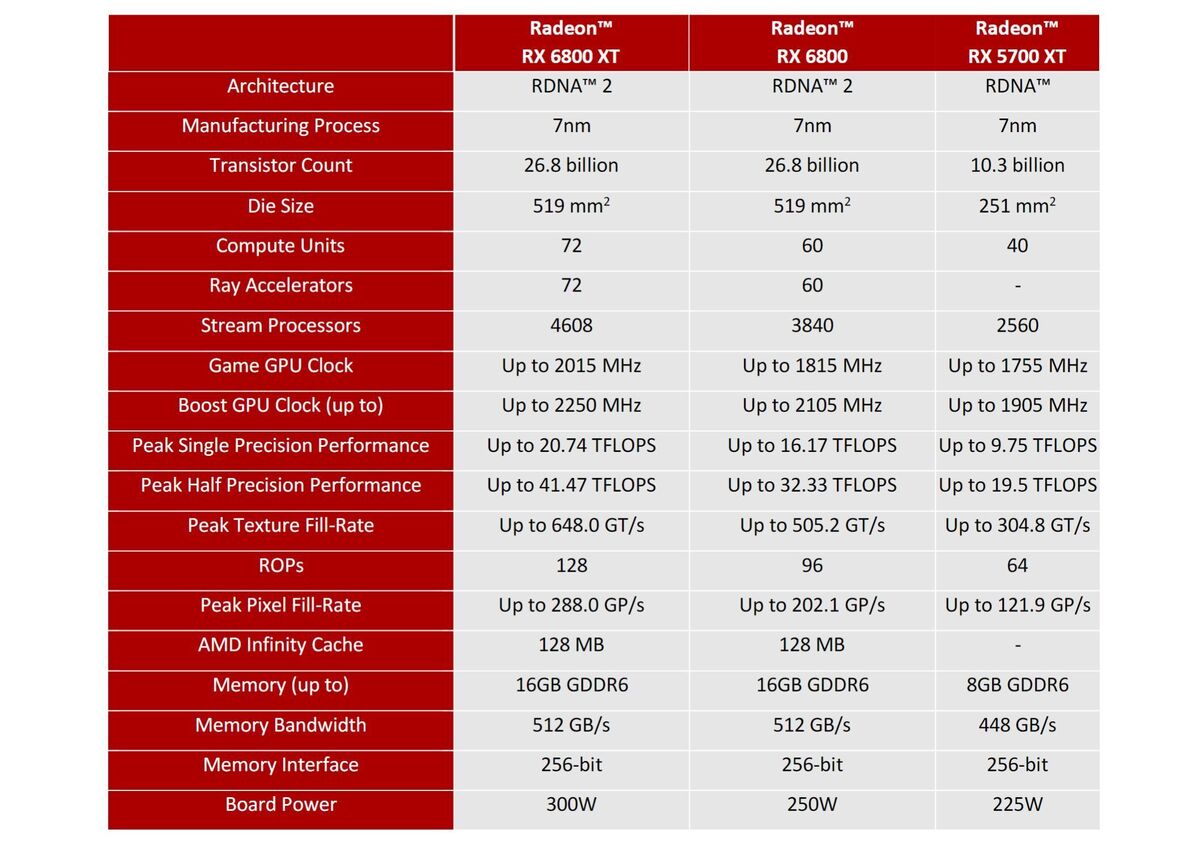 AMD
AMD Azure juiced the alfilaria on the Nitro+. The default Execution BIOS is rated for a 2,110MHz fair Game Time speed (+95MHz over reference) and a 2,360MHz maximum Boost speed (+110MHz over reference). That's slightly out front of the XFX Merc 319's default "Balanced" BIOS, though indistinguishable to the XFX card's "Rage" BIOS. Actual in-game clock speeds tend to go much high for all of these cards. AMD's intelligent boost algorithms adjust based on your graphics card's for sale power and energy limits, so they all offer essentially the same real-world carrying out.
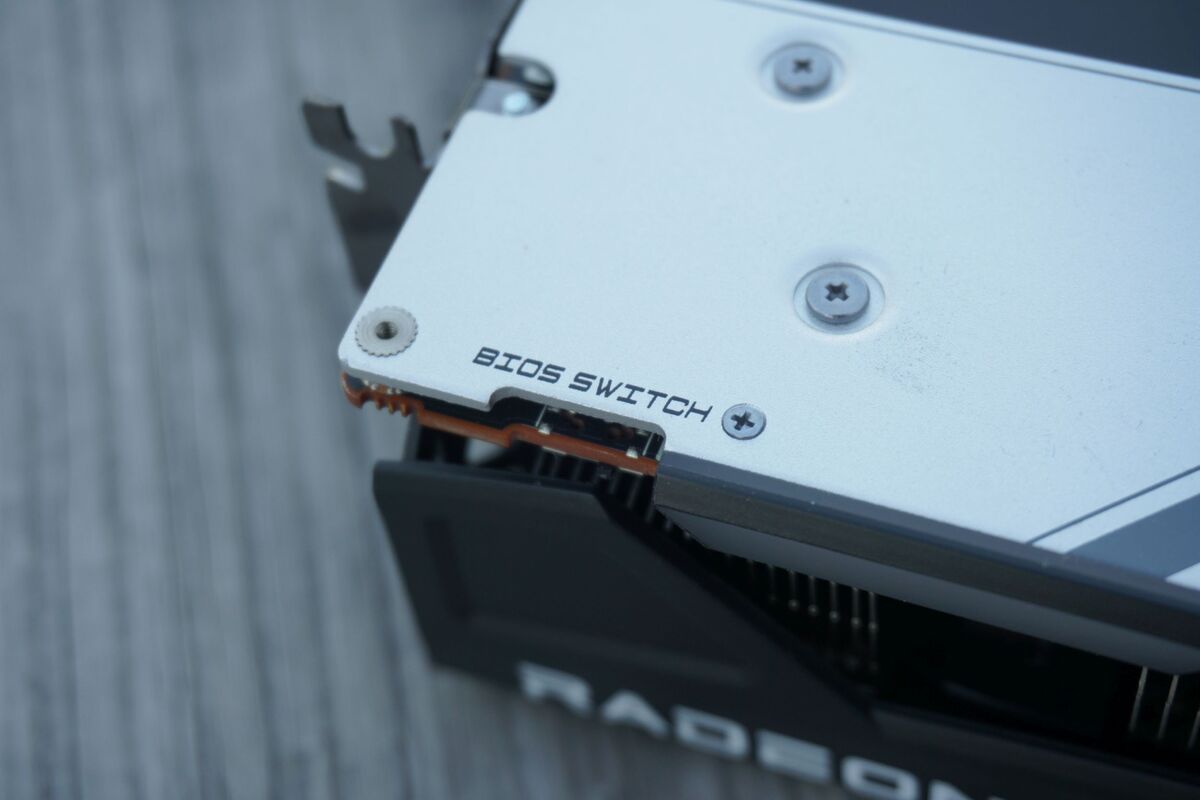 Brad Chacos/IDG
Brad Chacos/IDG Peerless BIOS, two BIOSes, thre BIOSes, ah ah ah
Sapphire also offers a secondary Quiet BIOS that slightly reduces clock and fan speeds for reinforced acoustic performance. You may opt it, atomic number 3 the default Performance BIOS is slightly audible. Information technology's what I'd use. The Nitro+ as wel includes a raw third BIOS switch that lets you choose between the Performance and Soft BIOSes using Sapphire's Trixx software, eliminating the pauperization to open your case to physically flip a hardware throw to change between the two. It's a lost, handy tactual sensation. This third position is really the configuration the card ships in, down for the Operation BIOS.
Sir Thomas More importantly, the new calling card also supports the fantastic Trixx Boost sport found in Sapphire's Trixx utility, which also manages the visiting card's RGB firing personal effects. Trixx Boost debuted with last generation's RDNA 1-based Nitro+ RX 5700 XT, and we instantly fell in love. The feature leverages AMD's excellent Radeon Image Sharpening ability by creating custom resolutions slightly below your monitor's true capabilities, then using RIS to clean upward the image when it's upscaled to fit your display. It works amazingly well in both performance uplift and seeable fidelity. We'll enshroud Trixx Hike in its own part after our standard benchmarks.
 Brad Chacos/IDG
Brad Chacos/IDG The Nitro+ packs in the variety of hefty cooling system performance that enthusiasts expect out of the steel. The cyber-terrorist-esque lightlessness-and-argent design looks similar to past iterations, but Sapphire changed quite a bit under the shroud—and the shroud itself. AMD and XFX use heavy all-argentiferous designs, as have past Nitro+ versions. The Nitro+ Radeon RX 6800 XT swaps that out for a plastic shroud to reduce the card's weight, successively reducing the sieve out on your motherboard's PCIe expansion slot.
Weight matters. Heavier designs can sometimes struggle with cleanly mounting the ice chest to the GPU die. Even if that isn't an emergence, bulky metal designs require extra physical considerations, atomic number 3 evidenced aside the extra bracketing ironware in the XFX Merc 319, and all the custom GeForce RTX 3080 card game that ship with a supplemental anti-sag square bracket in the boxwood.
The Sapphire Nitro+ RX 6800 XT weighs 2 pounds, 11 ounces—half arsenic much every bit the older Nitro+ Vega 64. That's also considerably less than the AMD reference invention's 3-pound, 5-ounce weightiness, and XFX's competition Merc 319, which tips the scales a hair shy of 4 pounds.
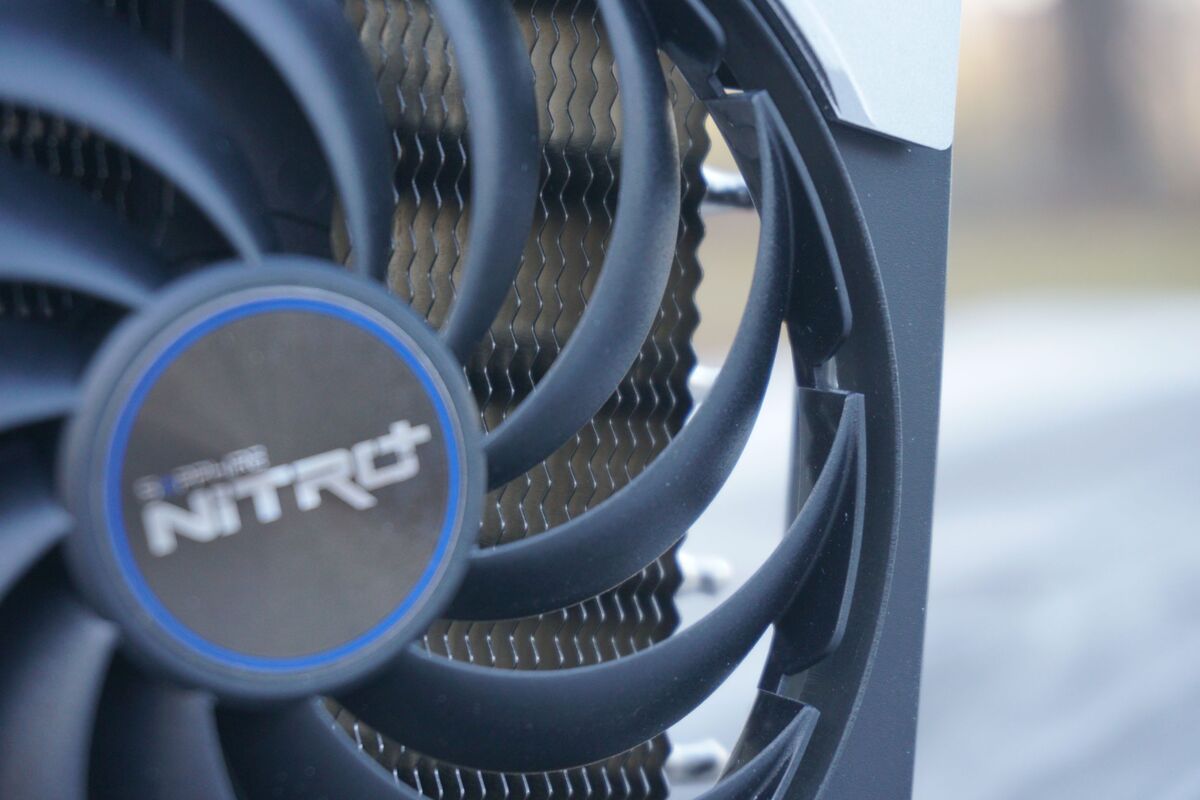 Brad Chacos/IDG
Brad Chacos/IDG You can see the Wave-shaped heatsink under the Nitro+'s swooping fans.
There's plenty of metal underneath all that plastic, though. The Nitro+'s heat sink runs the card's full 12.2-inch length, featuring a new wavy fin design that Sapphire claims helps to cut down on wind randomness. The metal complete the GPU itself tapers down with a V-shaped notch to "speed and centralize" the flow of air around the chip, per Sapphire. Sapphire included a standalone metal ice chest with its personal heatsinks and heatpipe for the memory, voltage regulators, and chokes. Taming temperatures on those components forever helps, but it should prove particularly receive during overclocking attempts.
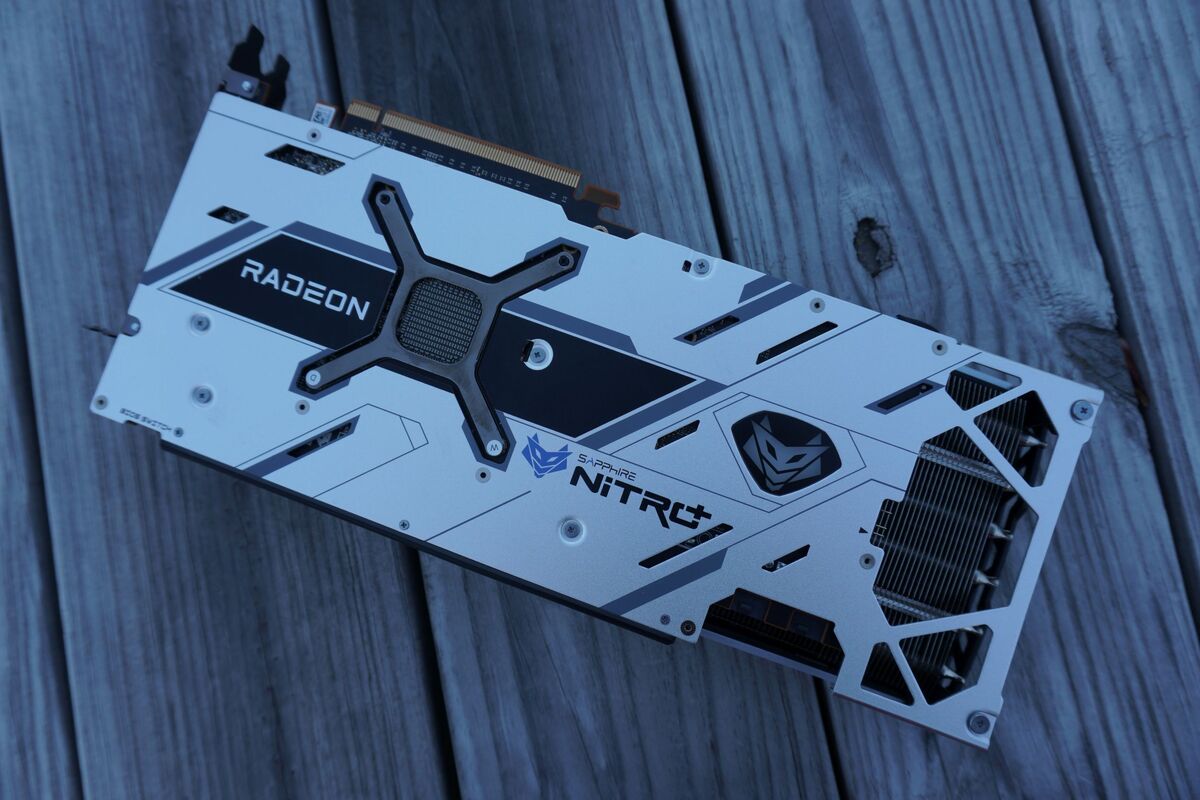 Brad Chacos/IDG
Brad Chacos/IDG Heat management is helped aside the long, futuristic-looking silver backplate, which definitely is not plastic. Customizable RGB kindling illuminates the logo on the backplate, the long luminance bar on the edge of the backplate, and the Cerulean cite happening the side of the card, with the ignitor attractively bleeding through the pocketable cutouts spaced crossways the backplate. The metal application also includes a large cutout at the end to allow air from the farthest fan to die off completely through the heatsink. Sapphire connected the backplate to the board's PCB via thick thermal pads, allowing the backplate to help with heat waste. Speaking of which, Sapphire says information technology used K6.5 memory pads, which it claims provides 38 percent better thermal conduction than standard K5 pads.
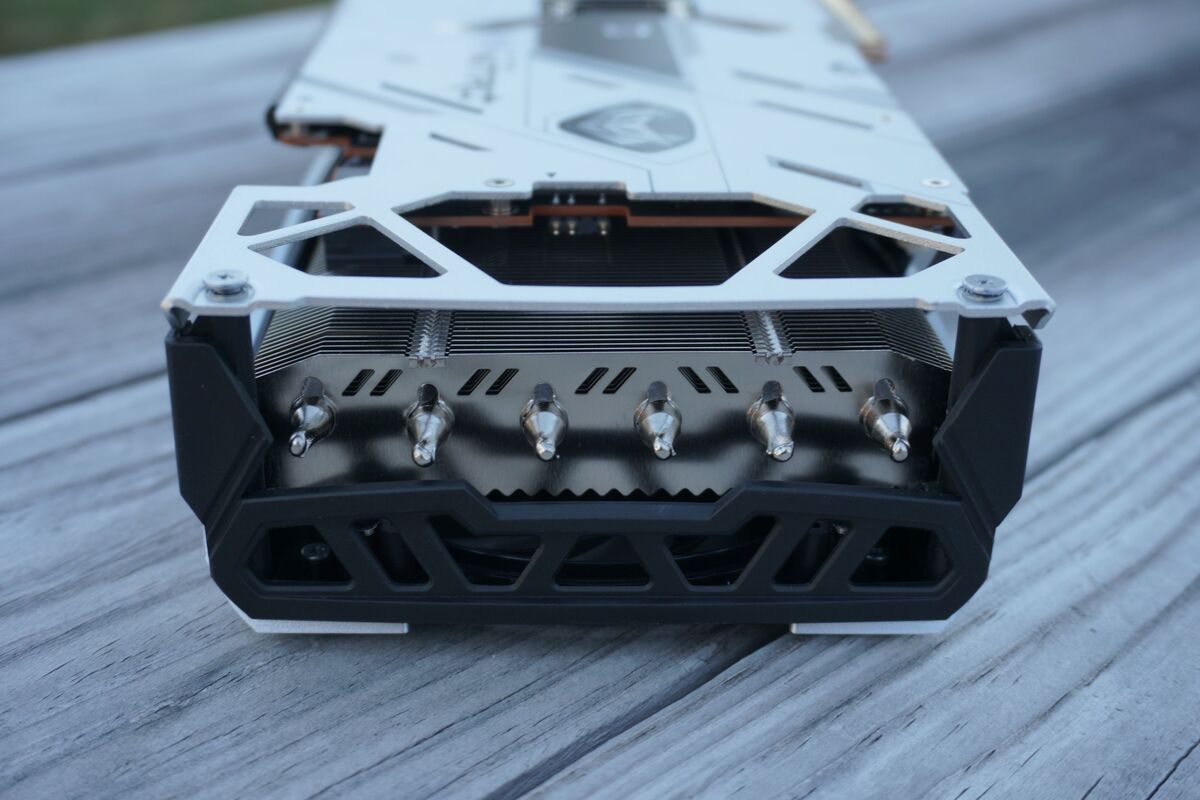 Brad Chacos/IDG
Brad Chacos/IDG But expect! We're not done nevertheless. All that bronze can't keep back things cool without air moving through it, so Sapphire overhauled the Nitro+'s fans also. The new "hybrid fan" blades merge characteristics from both axial and electric fan-expressive style fans, improving both flow of air and atmospheric pressure compared to yesteryear's axial fans while keeping noise levels low-pitched. Each fan comes loaded with 12 of the shallow, swooping blades. You can no more check their health condition in Trixx care you could with past Nitro+ models, however (surgery at least non yet).
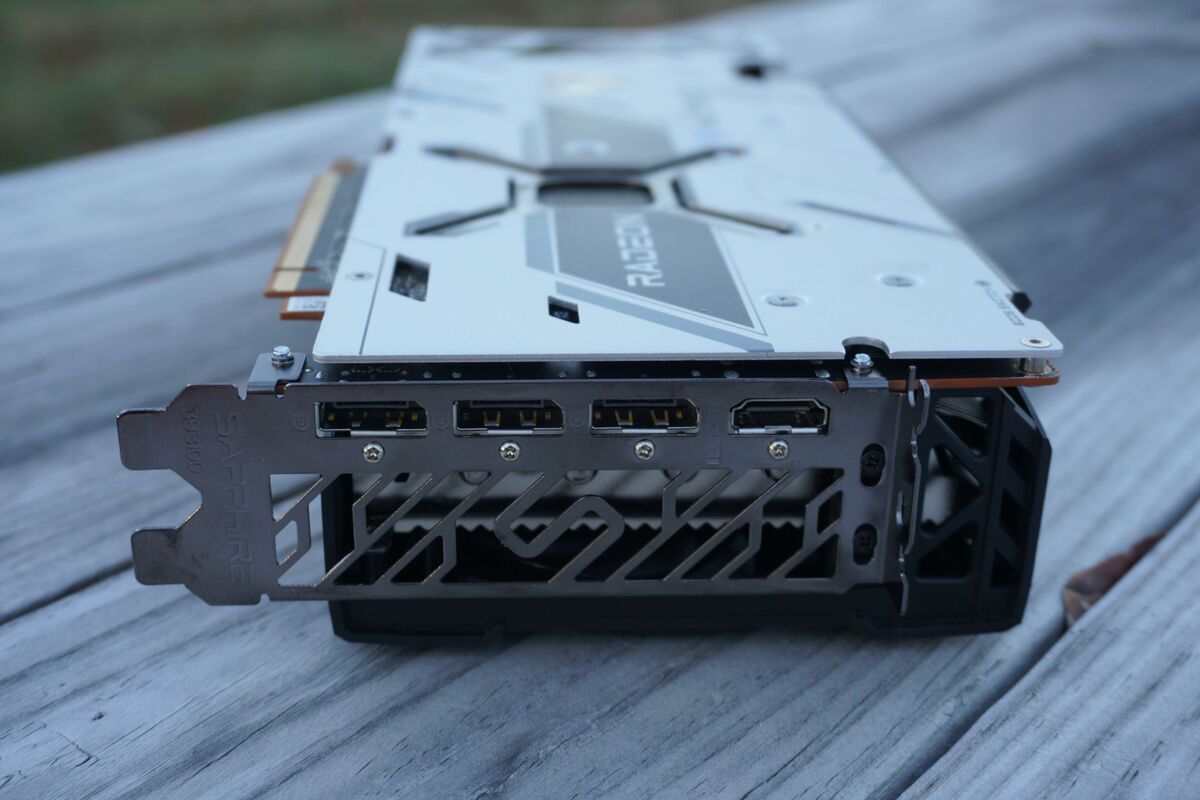 Brad Chacos/IDG
Brad Chacos/IDG Sapphire shook up the visual outputs, too. While AMD's book of fact design (and XFX's Merc 319) admit a USB-C port, the Nitro+ swaps it come out for an extra DisplayPort. That gives the card triad of the connections, on with an HDMI 2.1 port capable of powering 4K/144Hz or 8K/60Hz panels over a single cable.
Of course, as a Radeon RX 6000-serial publication card, the Nitro+ supports completely of AMD's latest features, including ray tracing, improved performance with Ryzen 5000 processors thanks to Smart Access Memory, FreeSync, Radeon Boost, Radeon Anti-Interim, AMD Link streaming, and more. Check out our original AMD Radeon RX 6800-series limited review for a deeper look at those.
Now, let's puzzle out to the benchmarks.
Incoming page: Our test system, benchmarks set out
Our try out system
Our dedicated graphics card essa system is a couple of years old, but it's packed with some of the quickest complementary components available to frame whatsoever possible operation bottlenecks squarely on the GPU, especially at the high resolving power these graphics cards target. Most of the hardware was provided by the manufacturers, but we purchased the cooler and storage ourselves.
- Intel Essence i7-8700K processor ($300 on Amazon) overclocked to 5GHz all cores
- EVGA CLC 240 closed-loop liquid cooler ($105 on Amazon)
- Asus Maximus X Hoagy motherboard
- 64GB HyperX Piranha RGB DDR4/2933 ($355 on Amazon)
- EVGA 1200W SuperNova P2 power supply ($352 on Amazon)
- Corsair Crystal 570X RGB case, with front and top of the inning panels removed and an extra bring up fan installed for improved airflow
- 2x 500GB Samsung 860 EVO SSDs ($70 each on Amazon)
We're comparison the $770 Sapphire Nitro+ Radeon RX 6800 XT with its default Functioning BIOS versus the $800 XFX RX 6800 XT Merc 319, as well Eastern Samoa AMD's character versions of the $579 Radeon RX 6800 and $649 Radeon RX 6800 XT. We're also pitting the card against the Founders Edition versions of its direct Nvidia rivals, the $500 GeForce RTX 3070 and $700 GeForce RTX 3080. For functioning comparisons against last-gen graphics cards, check out our original AMD Radeon RX 6800-series review.
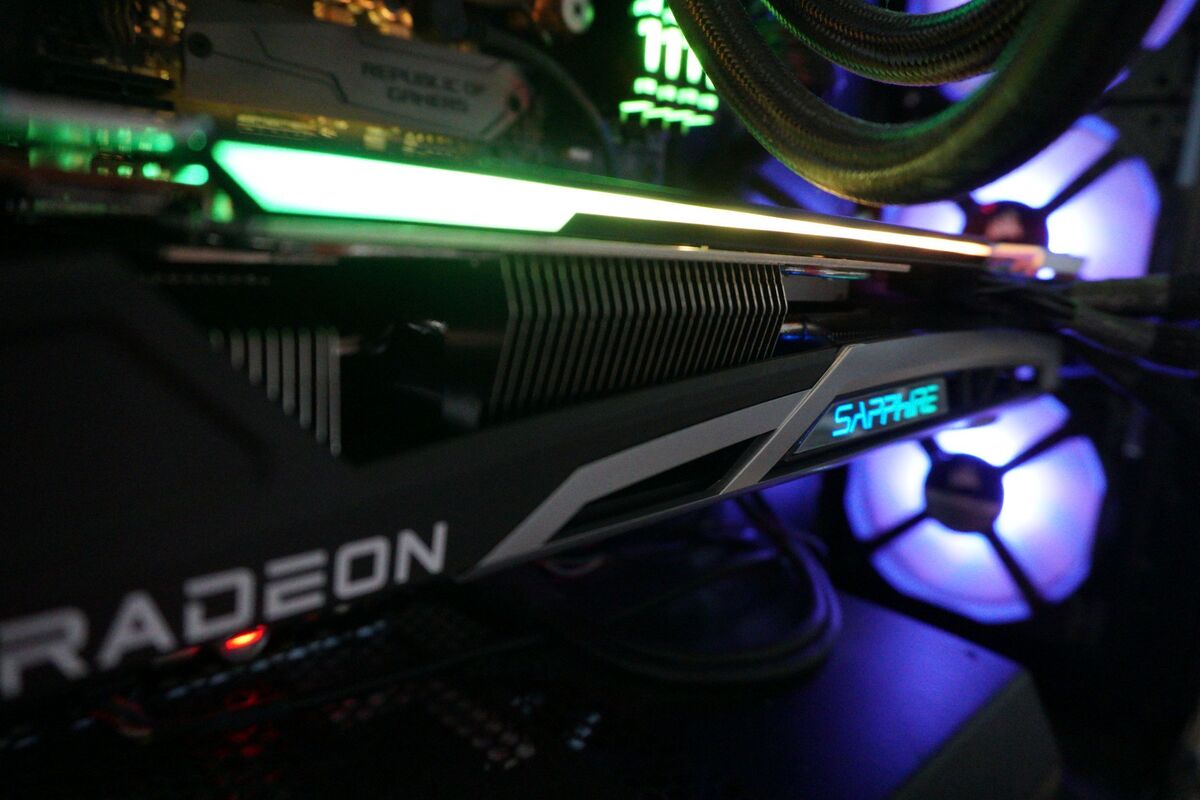 Brad Chacos/IDG
Brad Chacos/IDG The Sapphire Nitro+ in our test system.
We test a variety of games spanning various engines, genres, vendor sponsorships (Nvidia, AMD, and Intel), and art APIs (DirectX 11, DX12, and Vulkan). Each game is tried and true using its in-game benchmark at the highest possible graphics presets unless otherwise noted, with VSync, human body rate caps, time period ray tracing or DLSS effects, and FreeSync/G-Sync handicapped, on with any other marketer-specific technologies like FidelityFX tools or Nvidia Reflex. We've also enabled temporal anti-aliasing (TAA) to push these cards to their limits. We run each bench mark leastwise three multiplication and list the average result for each test.
Because Sapphire's card offers the same essential carrying out as AMD's reference card, we're going to preset our traditional benchmarks without extra commentary and hop-skip a deeper ray of light tracing analysis. (Spoiler: It's good for ray tracing at 1440p and 1080p resolution, but the lack of an Nvidia DLSS rival leaves it far behind GeForce's beam tracing performance.) Once more, tally verboten our originative AMD Radeon RX 6800-series review for more extensive performance analysis in for each one game.
Gaming performance benchmarks
Watch Dogs: Legion
Watch Dogs: Legionis one of the first games to debut connected next-gen consoles. Ubisoft upgraded its Disrupt engine to admit stylish features comparable real-time ray trace and Nvidia's DLSS. We disable those effects for this examination, butLegion remains a strenuous game symmetrical on high-end ironware with its ex gratia high-resolution texture bundle off installed. No card can maintain a 60-frames-per-intermediate average with Extremist graphics options enabled, and the game allocates Sir Thomas More than 8GB of memory smooth at 1440p. Oof.
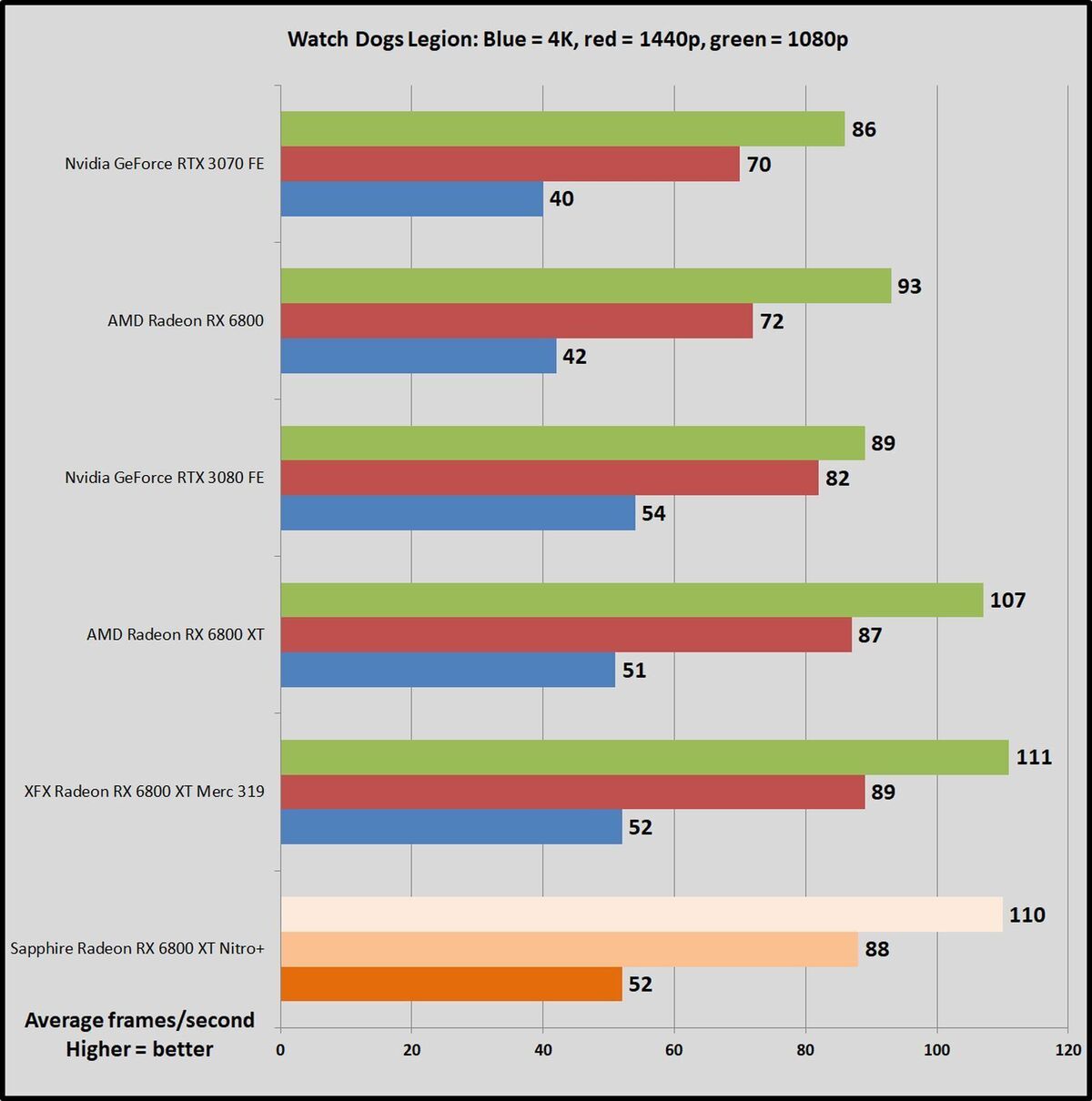 Brad Chacos/IDG
Brad Chacos/IDG Horizon Zero Dayspring
Yep, PlayStation exclusives are coming to the PC now.Horizon Zero Dawn runs on Guerrilla Games' Decima locomotive engine, the same railway locomotive that powersDeath Stranding. Close Occlusion hindquarters offer fluky results if set to Ultra, thusly we try thereupon setting at Average. Every other optical option is maxed out.
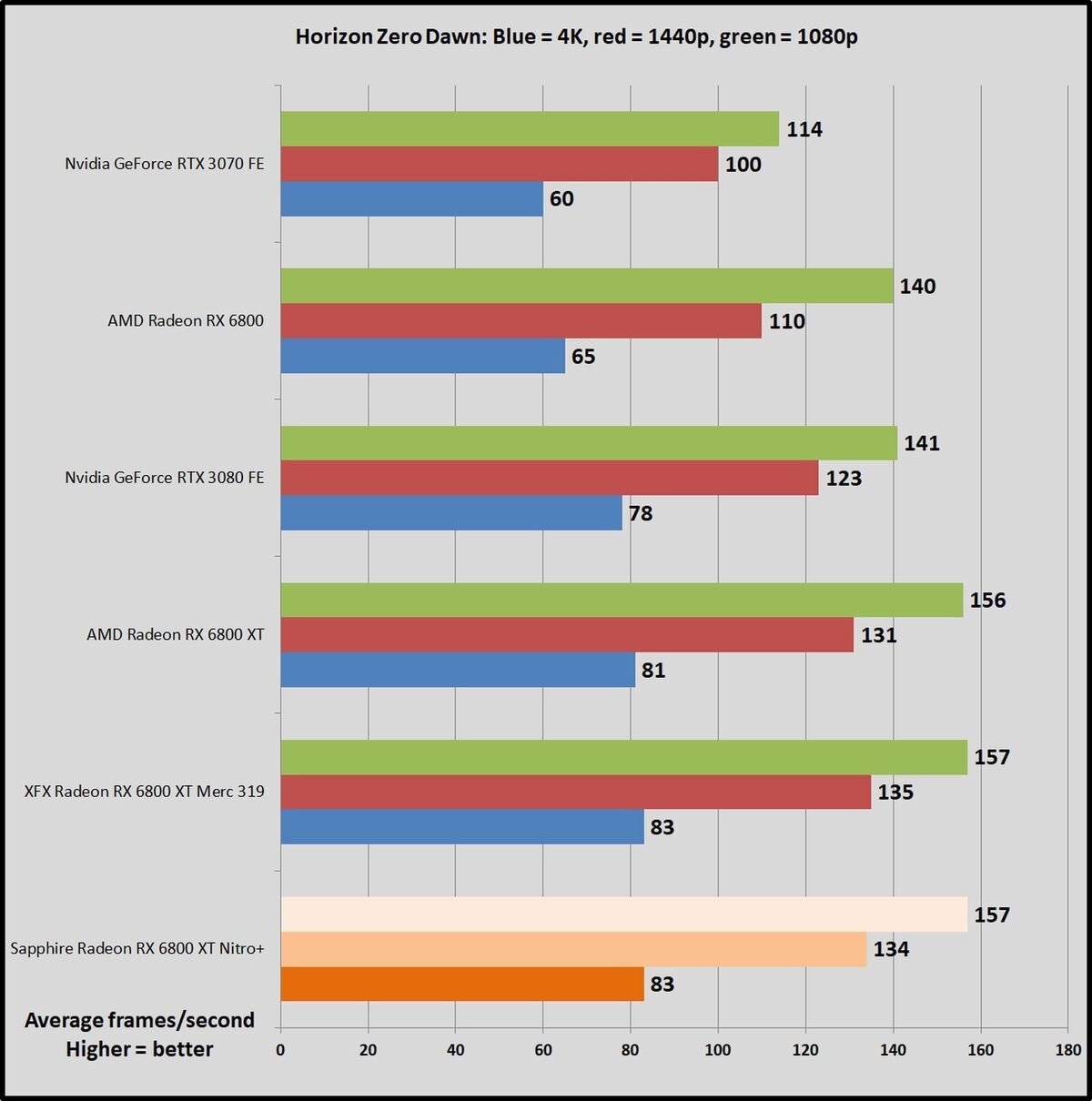 Brad Chacos/IDG
Brad Chacos/IDG Next page: play benchmarks continue
Gears Tactics
Gears Maneuver puts it possess brutal, fast-paced spin on theXCOM-like musical genre. This Unreal Engine 4-powered secret plan was stacked from the ground up for DirectX 12, and we have a go at it being able to work a tactics-style gimpy into our benchmarking suite. Improved yet, the game comes with a plethora of graphics options for PC snobs. More games should devote such loving care to explaining what flipping all these visual knobs skilled.
You force out't use the presets to benchmarkGears Tactics, as information technology intelligently scales to make for best on your installed hardware, meaning that "Ultra" on one graphics card can load different settings than "Ultra" connected a weaker card. We manually coif whol options to their highest possible settings.
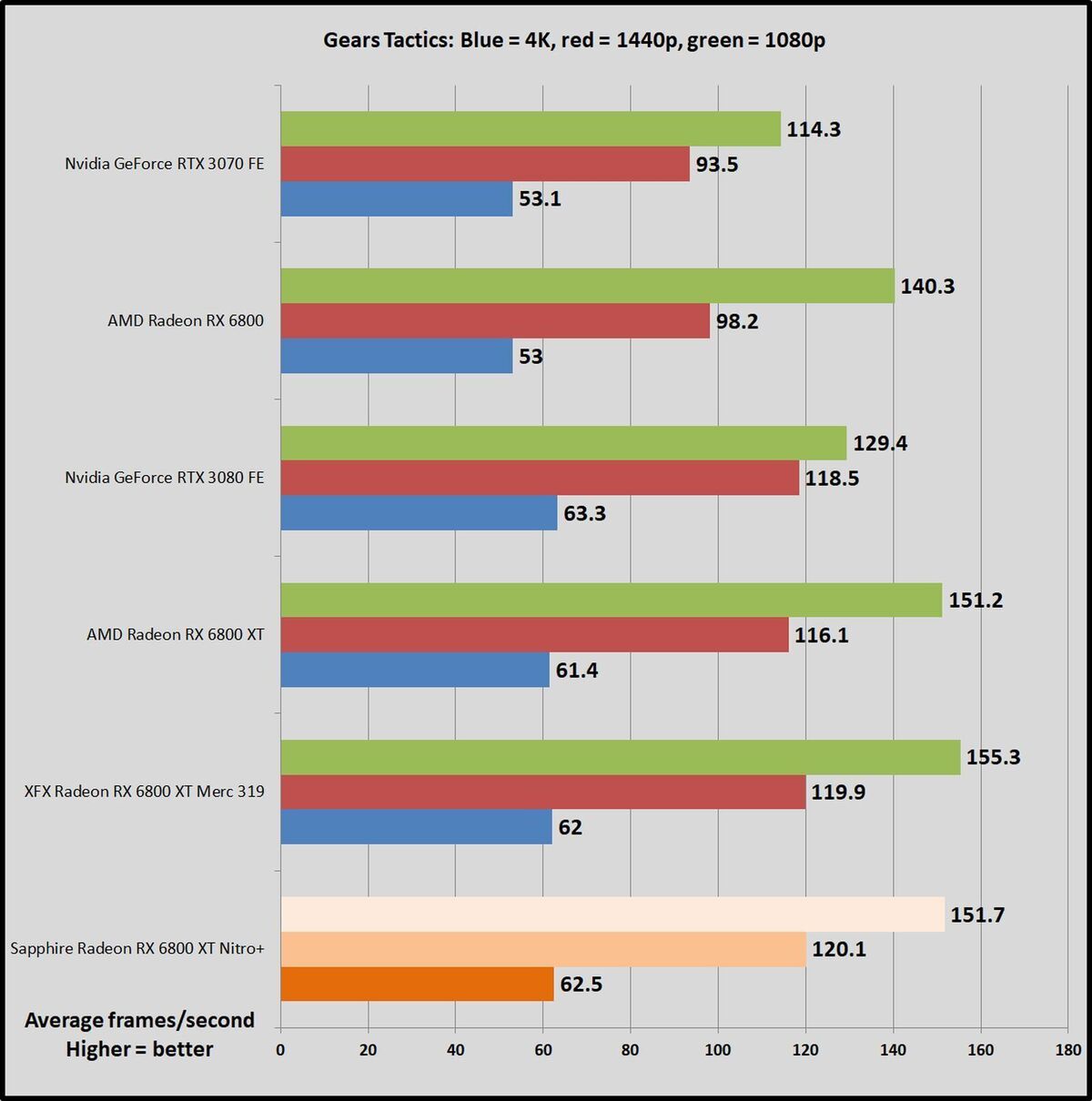 Brad Chacos/IDG
Brad Chacos/IDG Wolfenstein: Youngblood
Wolfenstein: Youngblood is more sport when you backside play cooperatively with a buddy, but it's a fearless try out—and an inviolable technical showcase. Running on the Vulkan API,Youngblood achieves blistering frame rates, and IT supports all sorts of cutting-edge technologies like shaft of light trace, DLSS 2.0, HDR, GPU culling, asynchronous calculation, and Nvidia's Content Adaptive Blending. The game includes a built-in benchmark with two different scenes; we tried Science laborator X.
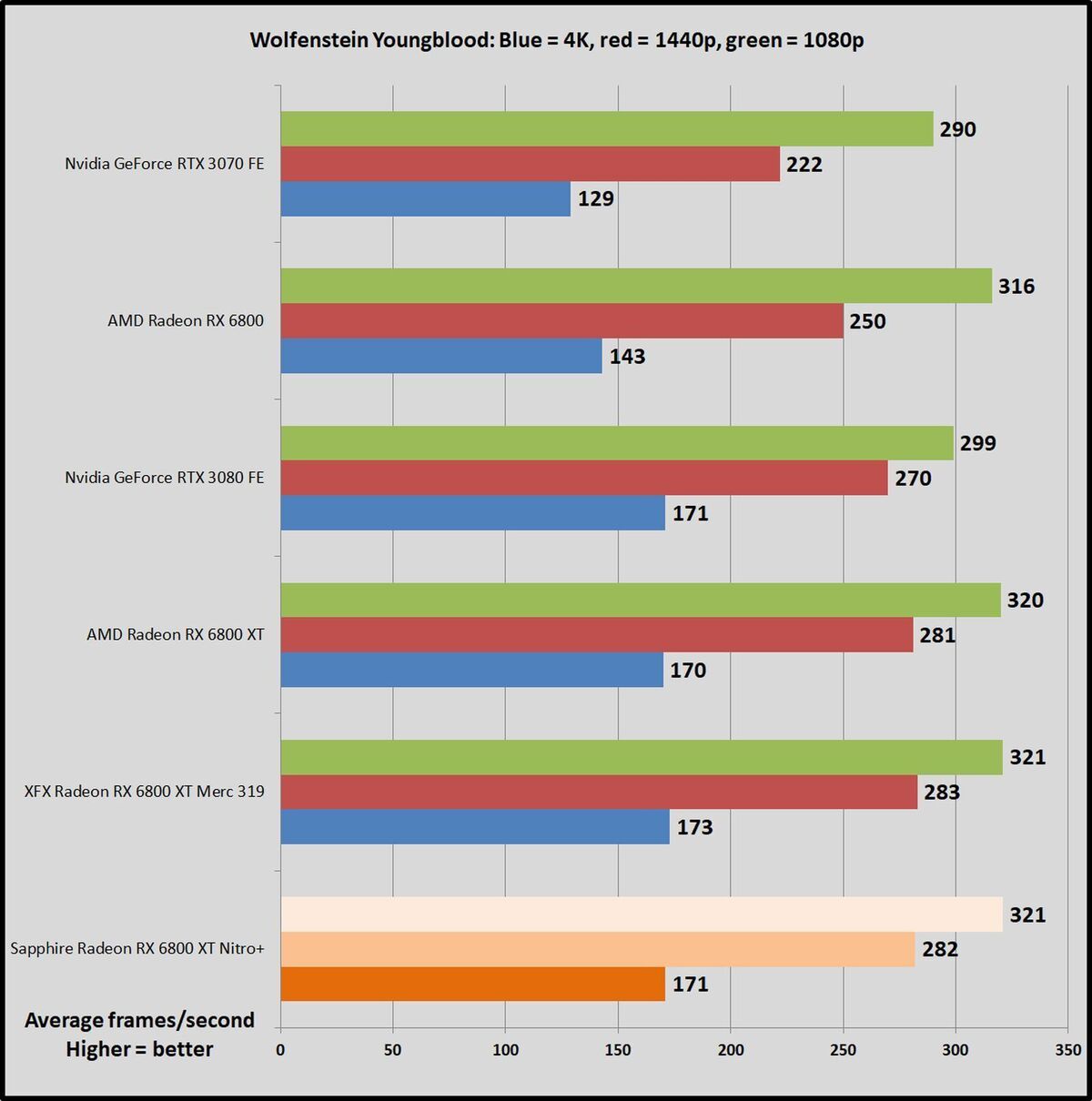 Brad Chacos/IDG
Brad Chacos/IDG Metro Exodus
One of the scoop games of 2019,Metro Exodusis one of the best-looking at games around, too. The stylish interlingual rendition of the 4A Engine provides incredibly luscious, ultra-detailed visuals, with one of the almost stunning time period irradiatio tracing implementations released yet. We test in DirectX 12 mode with ray trace, Hairworks, and DLSS injured for our basic benchmarks.
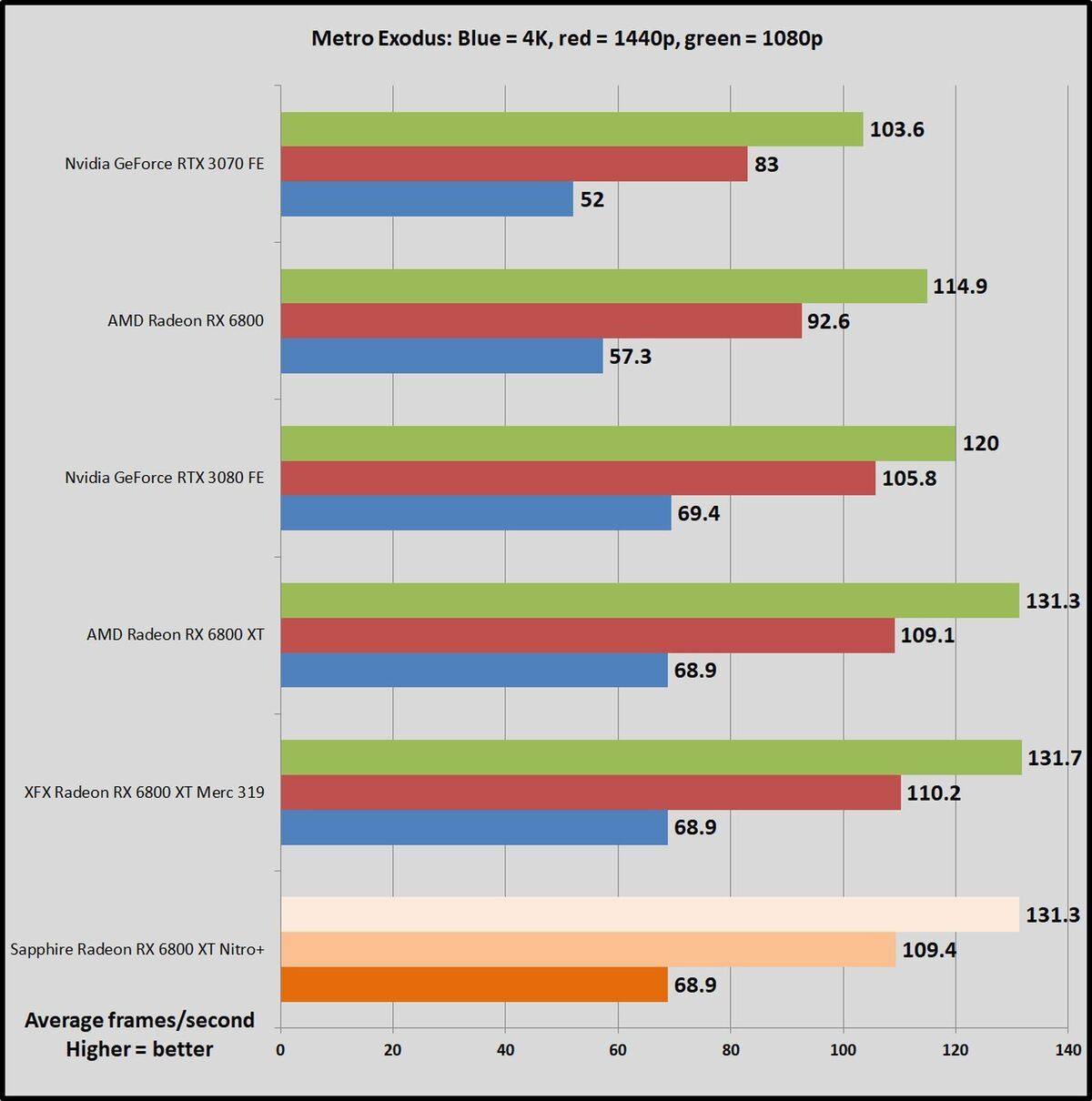 Brad Chacos/IDG
Brad Chacos/IDG Borderlands 3
Borderlands is back! Gear case's game defaults to DX12, so we make out as well. Information technology gives us a glimpse at the ultra-popular Unreal Engine 4's performance in a time-honoured shooter.
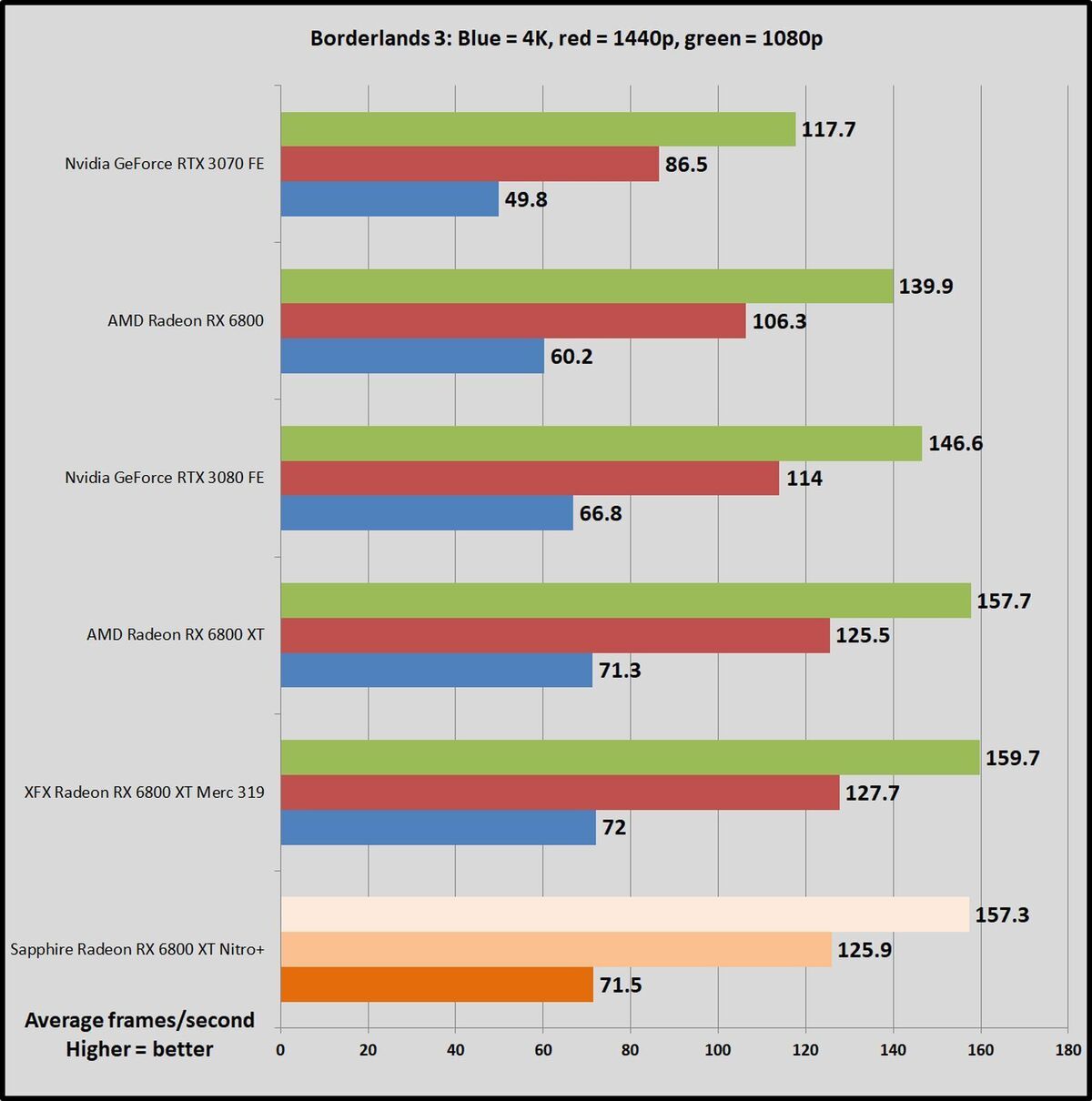 Brad Chacos/IDG
Brad Chacos/IDG Strange Brigade
Strange Brigade is a cooperative third base-person triggerman where a team of adventurers blasts through with hordes of mythological enemies. It's a technological show window, made-up around the next-gen Vulkan and DirectX 12 technologies and infused with features like HDR support and the ability to toggle asynchronous compute on and off. Information technology uses Rebellion's customs Azure engine. We exam using the Vulkan renderer, which is faster than DX12.
 Brad Chacos/IDG
Brad Chacos/IDG Side by side Thomas Nelson Page: play benchmarks continue
Total Warfare: Troy weight
The latest game in the commonEntire War saga,Troywas given away free for its first 24 hours on the Epic Games Store, stirring over 7.5 million copies earlier it went on proper sale.Total War: Troy is built using a adapted version of theTotal War: Warhammer 2 engine, and this DX11 title looks disorienting for a turn-based strategy lame. We test the more intensive battle benchmark.
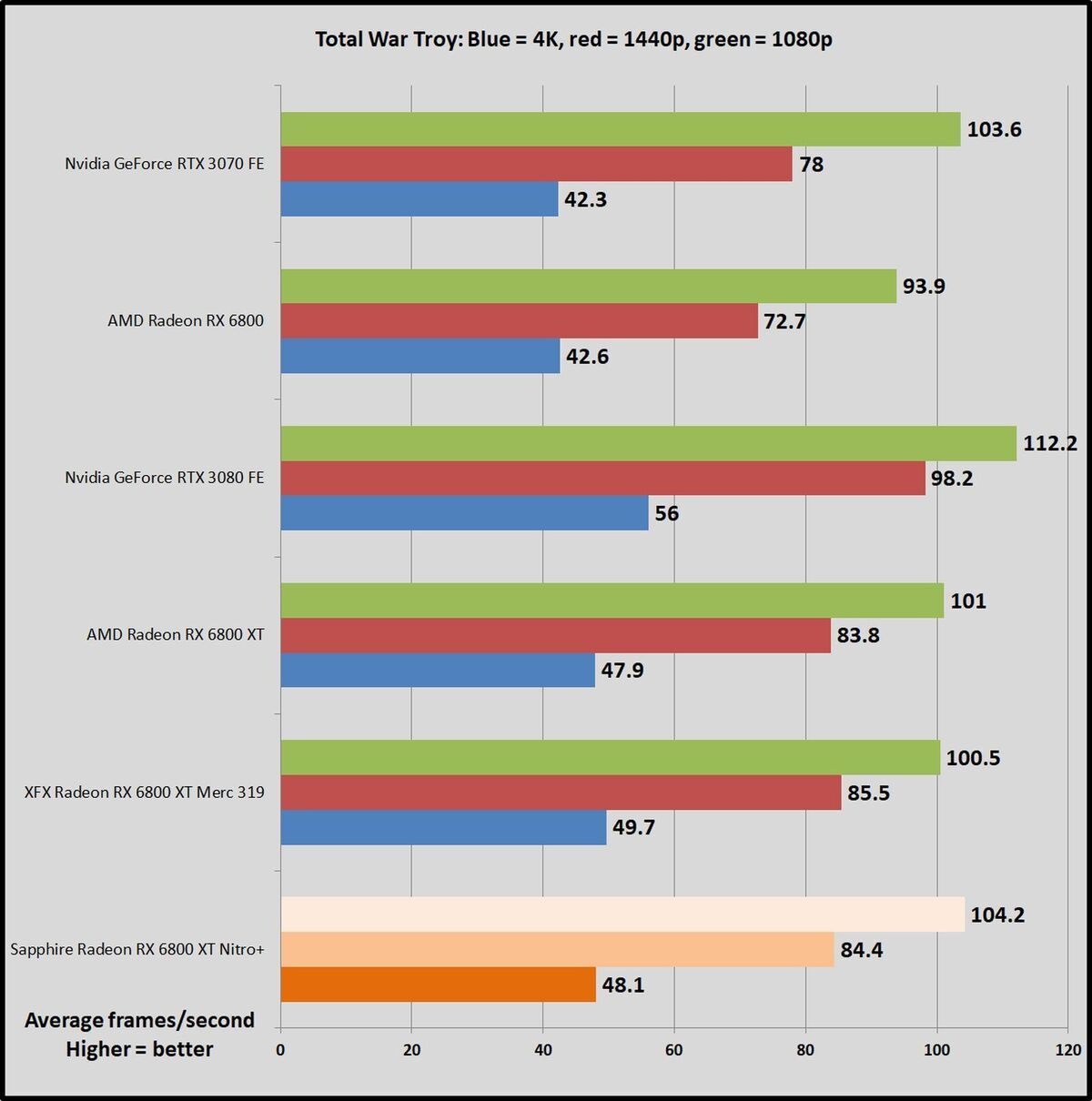 Brad Chacos/IDG
Brad Chacos/IDG F1 2020
The a la mode in a overnight line of made racing games,F1 2020is a gem to trial run, provision a spacious range of both graphical and benchmarking options, making it a much more reliable (and play) option that theForzaseries. It's built on the latest variant of Codemasters' buttery-smooth Ego game engine, complete with support for DX12 and Nvidia's DLSS technology. We test ii laps on the Australia course, with clear skies happening and DLSS sour.
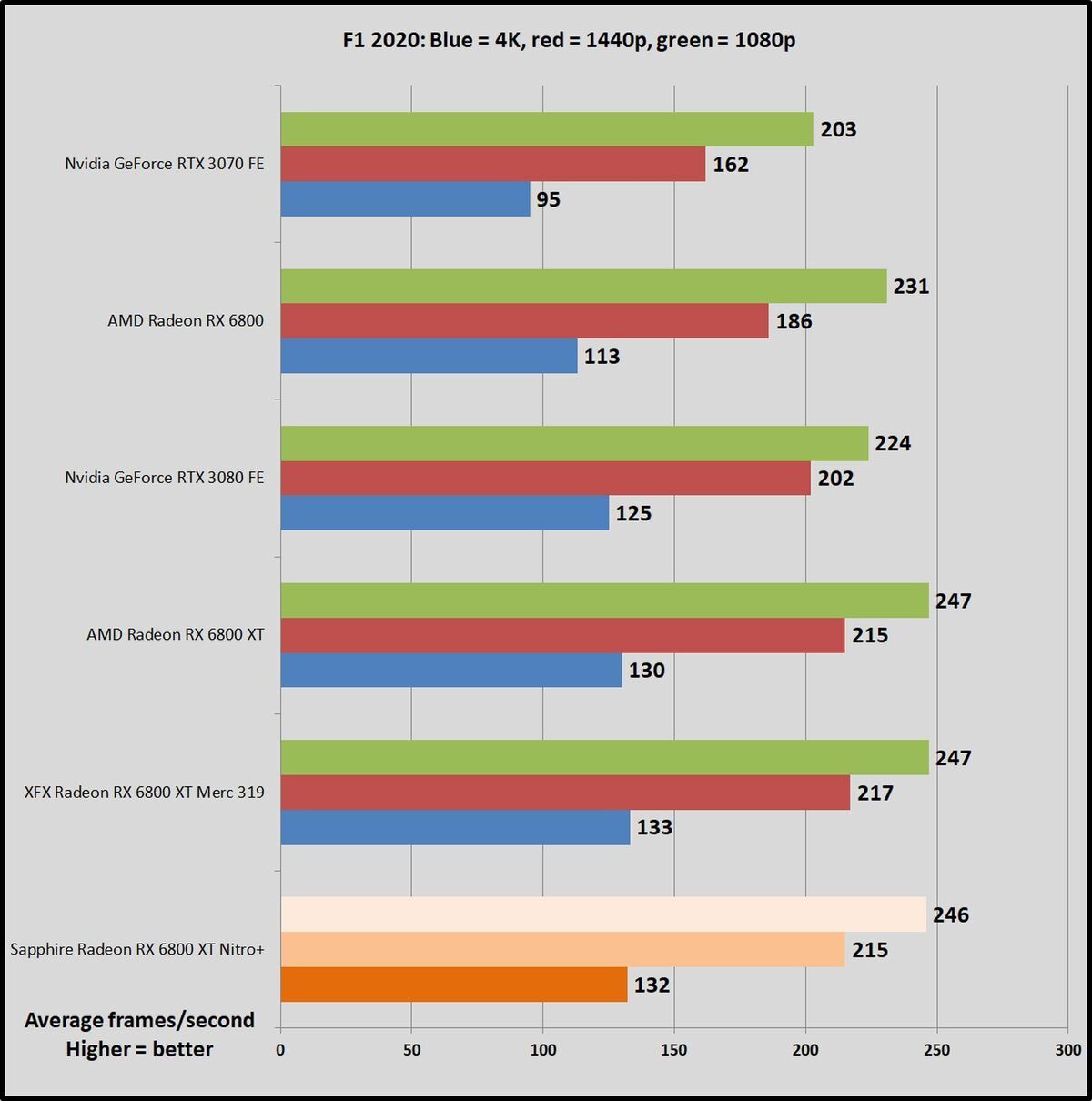 Brad Chacos/IDG
Brad Chacos/IDG Shadow of the Grave Freeboote
Shadow of the Tomb Despoiler concludes the reboot trilogy, and information technology's deadgorgeous. Lawful Enix optimized this gritty for DX12, and recommends DX11 only if you're using older hardware or Windows 7, so we test with DX12.Shadow of the Tomb Raider uses an enhanced version of the Foundation locomotive engine that too poweredRise of the Tomb Raider and includes optional existent-metre ray tracing and DLSS features.
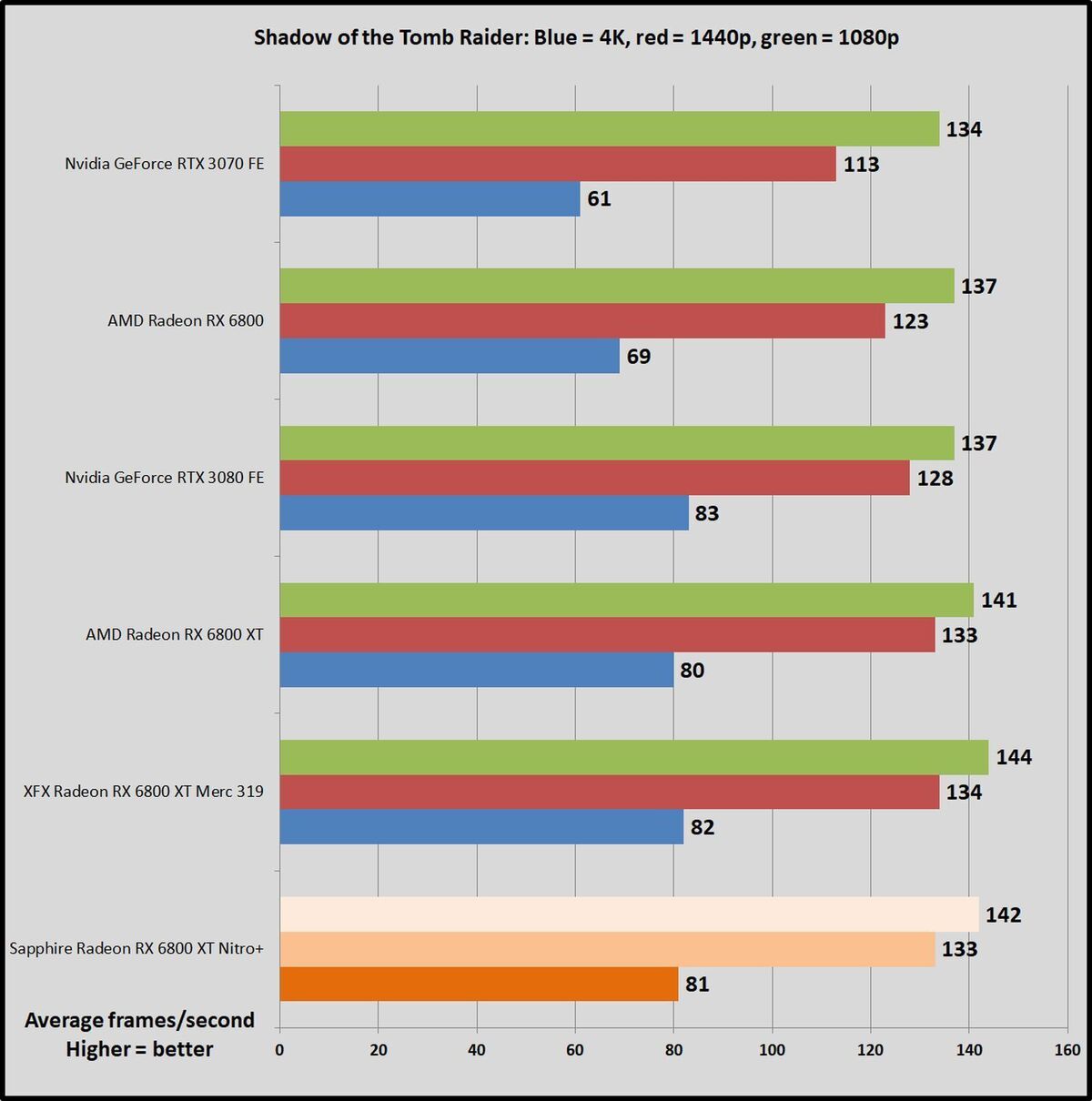 Brad Chacos/IDG
Brad Chacos/IDG Rainbow Six Siege
LikeGTA V, Ubisoft'sRainbow Six Siege still dominates the Steam charts years after its launch, and it'll glucinium getting a seeable upgrade for the next-gen consoles. The developers have poured a ton of work into the game's AnvilNext railway locomotive over the age, at length rolling out a Vulkan version of the game that we use to essa. By default, the brave lowers the deliver scaling to increase compose rates, but we set it to 100 percentage to bench mark native rendering performance on nontextual matter cards. Even still, skeletal frame rates soar upwards.
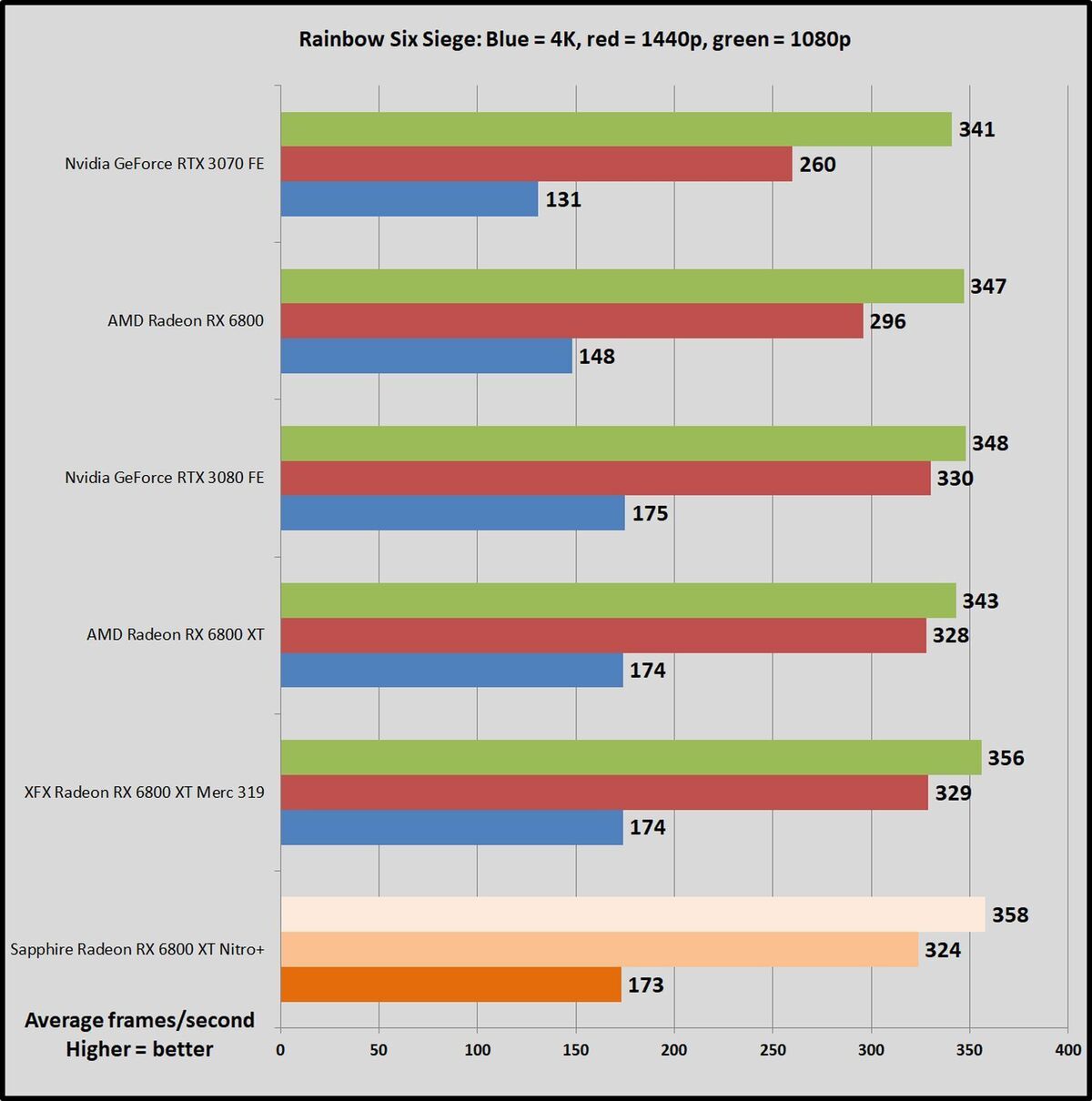 Brad Chacos/IDG
Brad Chacos/IDG Following page: Trixx Encouragement performance
Trixx Boost: Somewhat lower resolution, much higher performance, just-as-good graphics
Trixx Boost is a feature Sapphire added to endmost contemporaries's RDNA 1-founded Nitro+ RX 5700 XT, configurable using the party's Trixx management computer software, which also controls the graphics card's lighting personal effects.
The characteristic leverages the Radeon Image Sharpening feature AMD debuted alongside the RDNA architecture. Trixx Boost creates custom resolutions just below standard 1080p, 1440p, and 4K, which are then upscaled to fit your expose. Radeon Image Sharpening (which works with all major graphics Genus Apis now) cleans away the indistinct effects commonly associated with image upscaling. When you select the new custom-built resolutions in your game's graphics options, performance soars, as you'll see below.
It's wicked-smart, and I'm dismayed other GPU makers with software suites haven't cribbed it. Honestly, Trixx Further does nothing you can't do manually with any graphics card by cobbling together usage resolutions in AMD or Nvidia control panels, then turning on AMD surgery Nvidia's sharpening features. That's a complicated process that entails diving deep into control panel submenus though, limiting IT to enthusiasts. Trixx Boost makes it easy, and you rear end set information technology up in mere minutes.
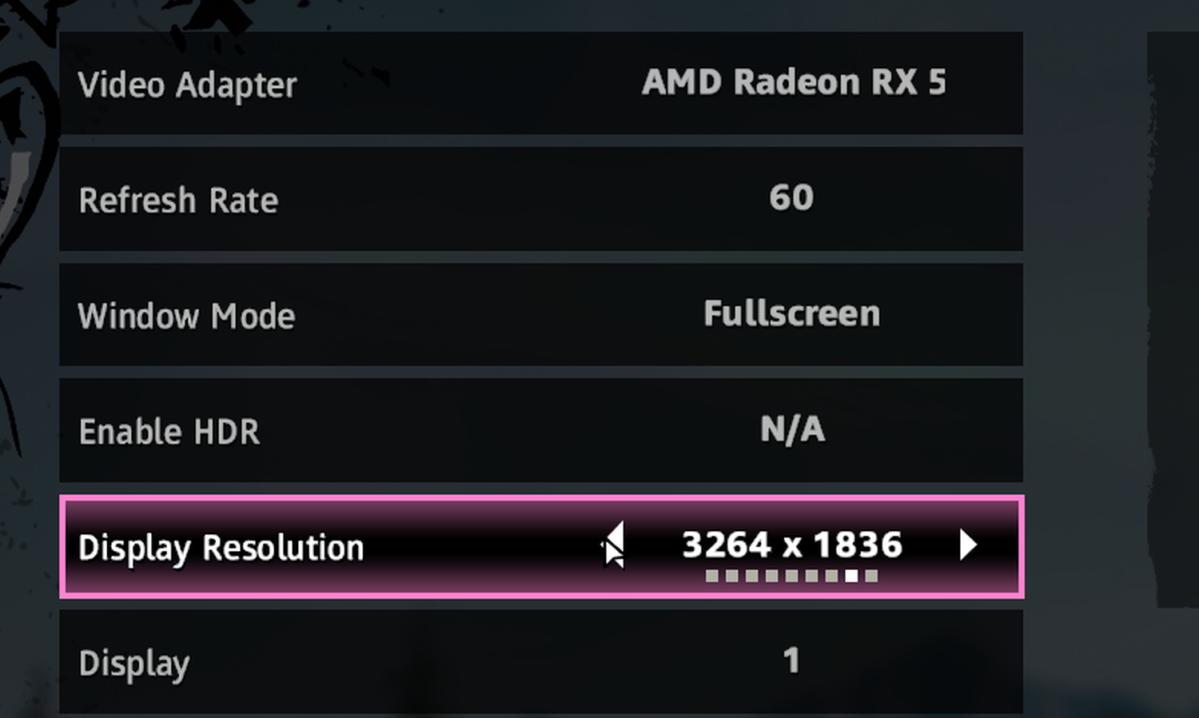 Brad Chacos/IDG
Brad Chacos/IDG Screenshot of a custom resolution created using Sapphire's Trixx Boost software system. Select these in your games rather than native 4K, 1440p, or 1080p to get Trixx Boost's benefits.
Open the Boost chit in Trixx, utilise a slider to regulate at what part of the original resolutions you want the custom resolutions created for—the default is 85 percent, which works great with the 4K and 1440p gameplay this card targets—and flick Utilise. Your screen will shoot a few times. The Trixx Cost increase interface utilised to include a button that let you turn on Radeon Image Sharpening redress inside Trixx, simply we didn't see information technology with the Nitro+ RX 6800 Crosstalk installed. You'll penury to head into the global display portion of AMD's Radeon Software and enable IT. That makes Trixx Boost slightly fewer seamless than before, but the setting is easy to find, and you'll need to activate only once for it to work all told games.
After that's done, simply select the New custom resolutions rather than the usual 4K, 1440p, and 1080p options in your gimpy settings and watch frame rates soar. How high? Feel out this lesser sampling of games, confiscated using the 85-percent default option grading:
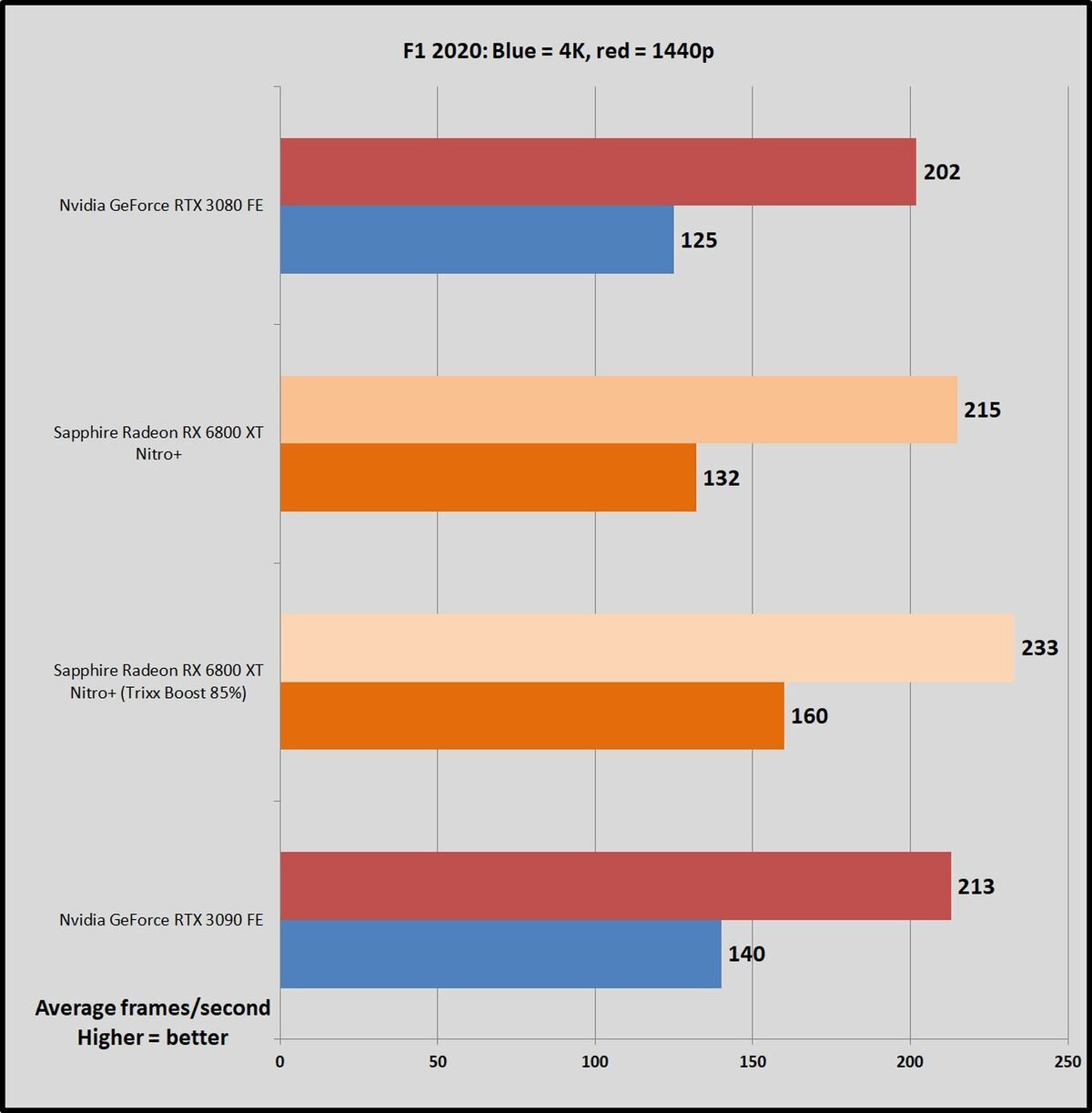 Brad Chacos/IDG
Brad Chacos/IDG 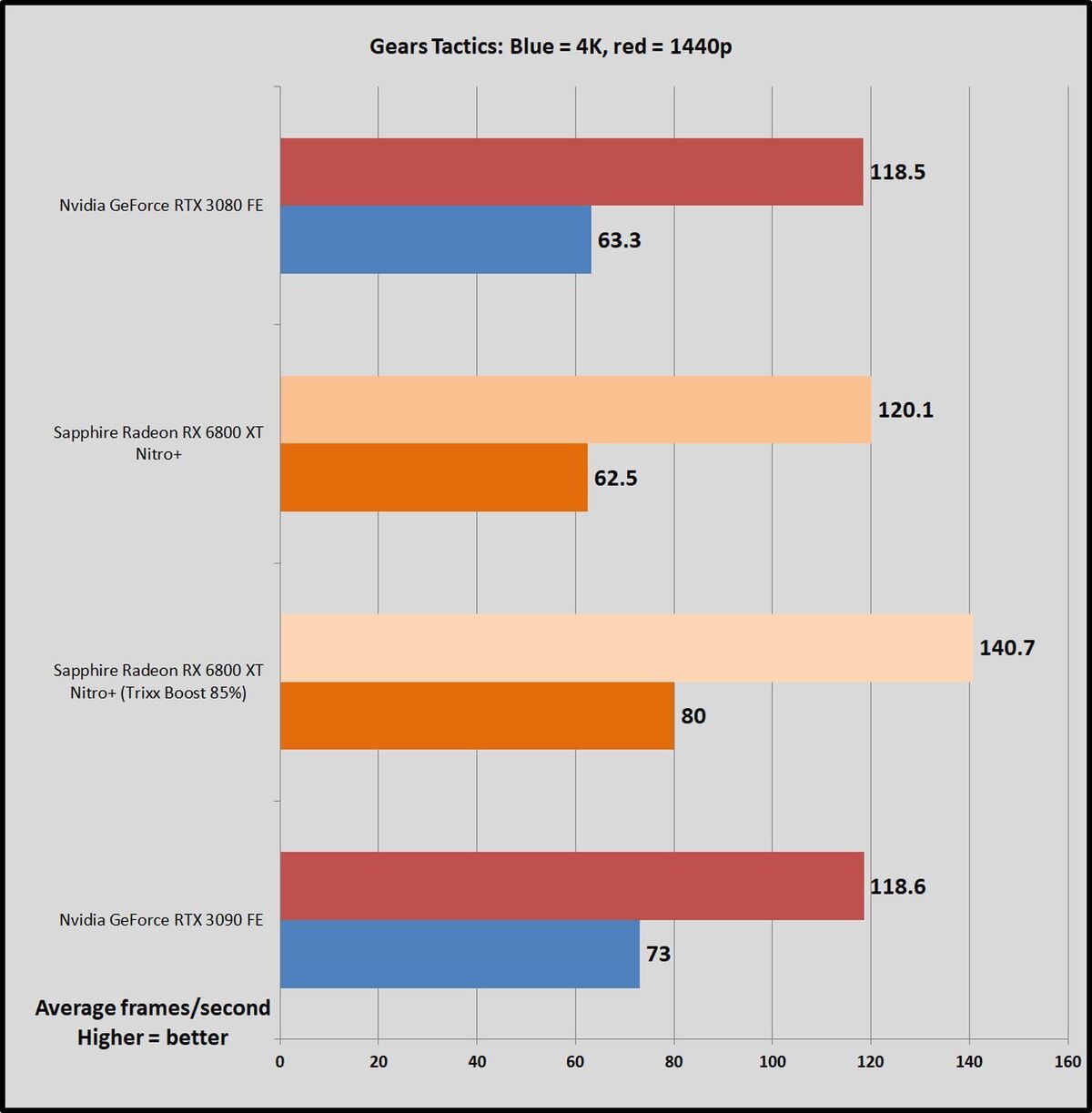 Brad Chacos/IDG
Brad Chacos/IDG 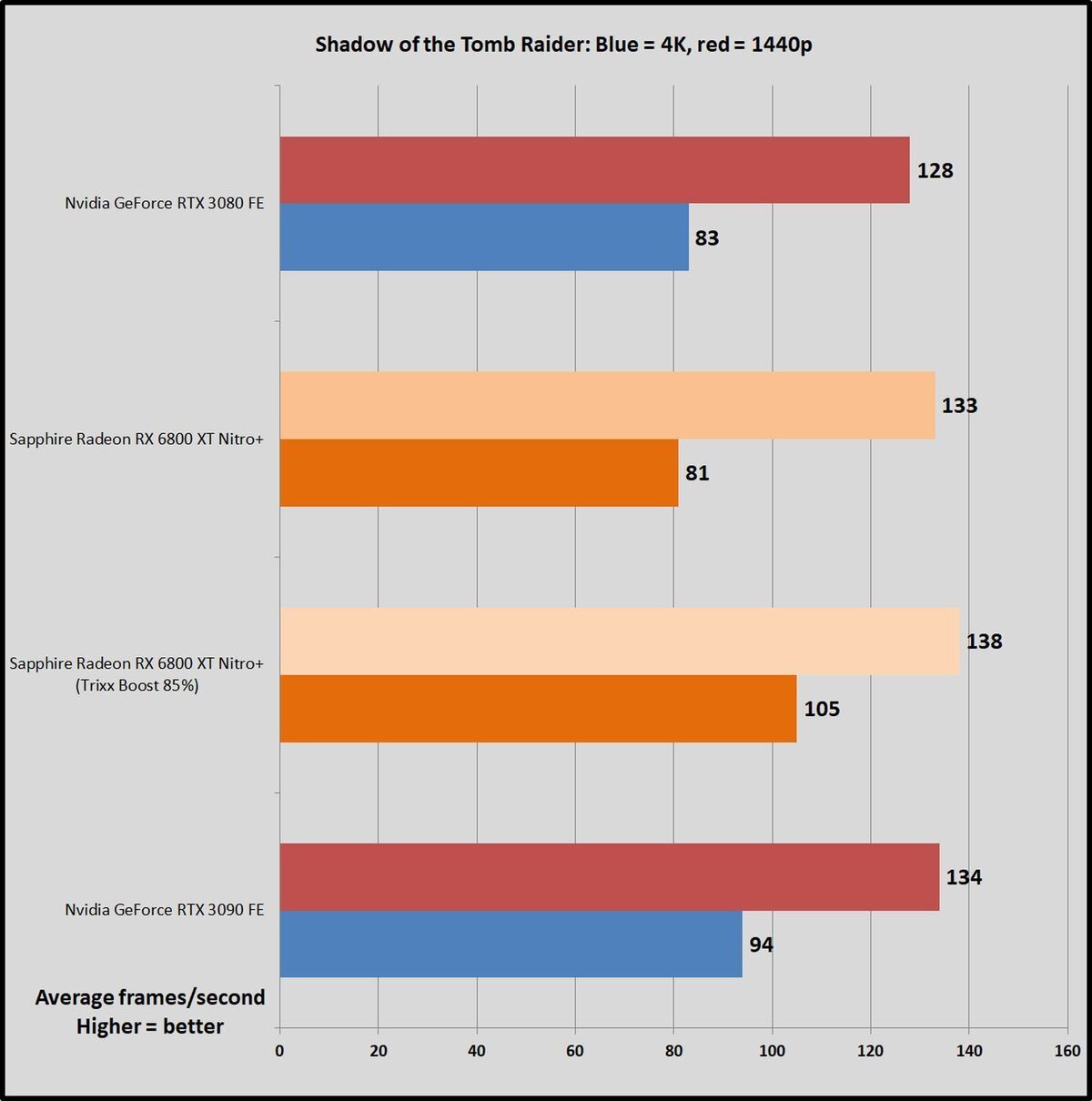 Brad Chacos/IDG
Brad Chacos/IDG 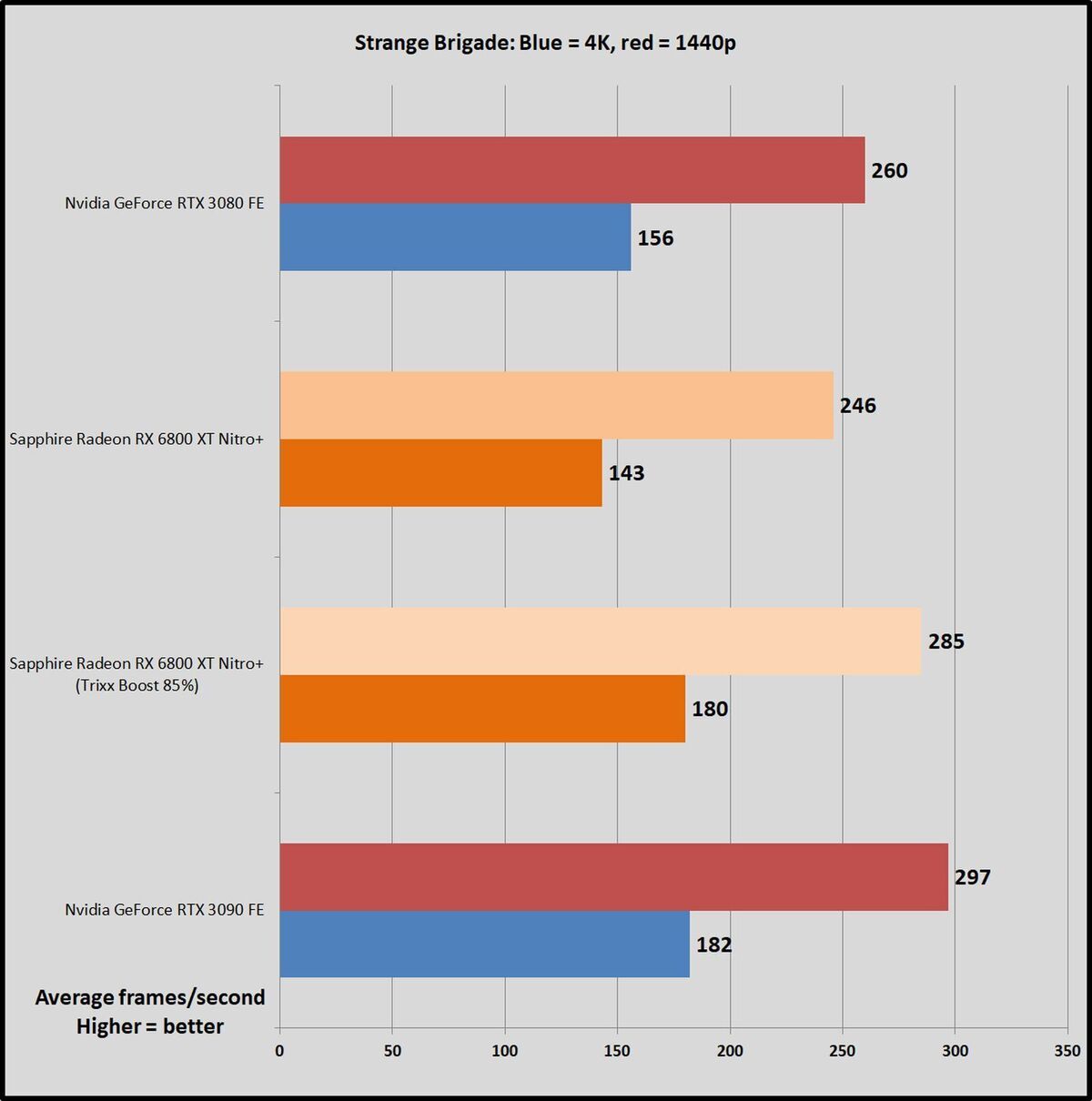 Brad Chacos/IDG
Brad Chacos/IDG As you can see, energizing Trixx Boost turbocharges carrying out to such lofty heights that Sapphire's Nitro+ Radeon RX 6800 XT topples fifty-fifty the behemoth $1,500 GeForce RTX 3090 in about games. Yes please! The faster frame rates could also help with light beam tracing performance, though we didn't have a chance to test that extensively.
If you find the default 85 pct custom resolution scaling overly foggy or otherwise compromised—we didn't—you bathroom inch it foul closer to native-born 100-percent scaling in granular one-percent increments until you find the dulcet spot for your eyes. The closer you get to aboriginal declaration, the lower the performance gains, however.
Next page: Power, thermals, and noise
Power draw, thermals, and noise
We test power draw by looping theF1 2020 bench mark at 4K for about 20 minutes after we've benchmarked everything else and noting the highest indication along our Watts Up Pro meter, which measures the index consumption of our entire try out system. The initial take off of the run off, where completely competing cars are onscreen simultaneously, tends to be the most demanding portion.
This International Relations and Security Network't a whip-case test; we removed the Core i7 8700K's overclock and specifically chose a GPU-bound spunky running at a GPU-bound resolution to gauge performance when the graphics card is sweating hard. If you're playing a courageous that also hammers the CPU, you could see higher overall system powerfulness draws. Consider yourself warned.
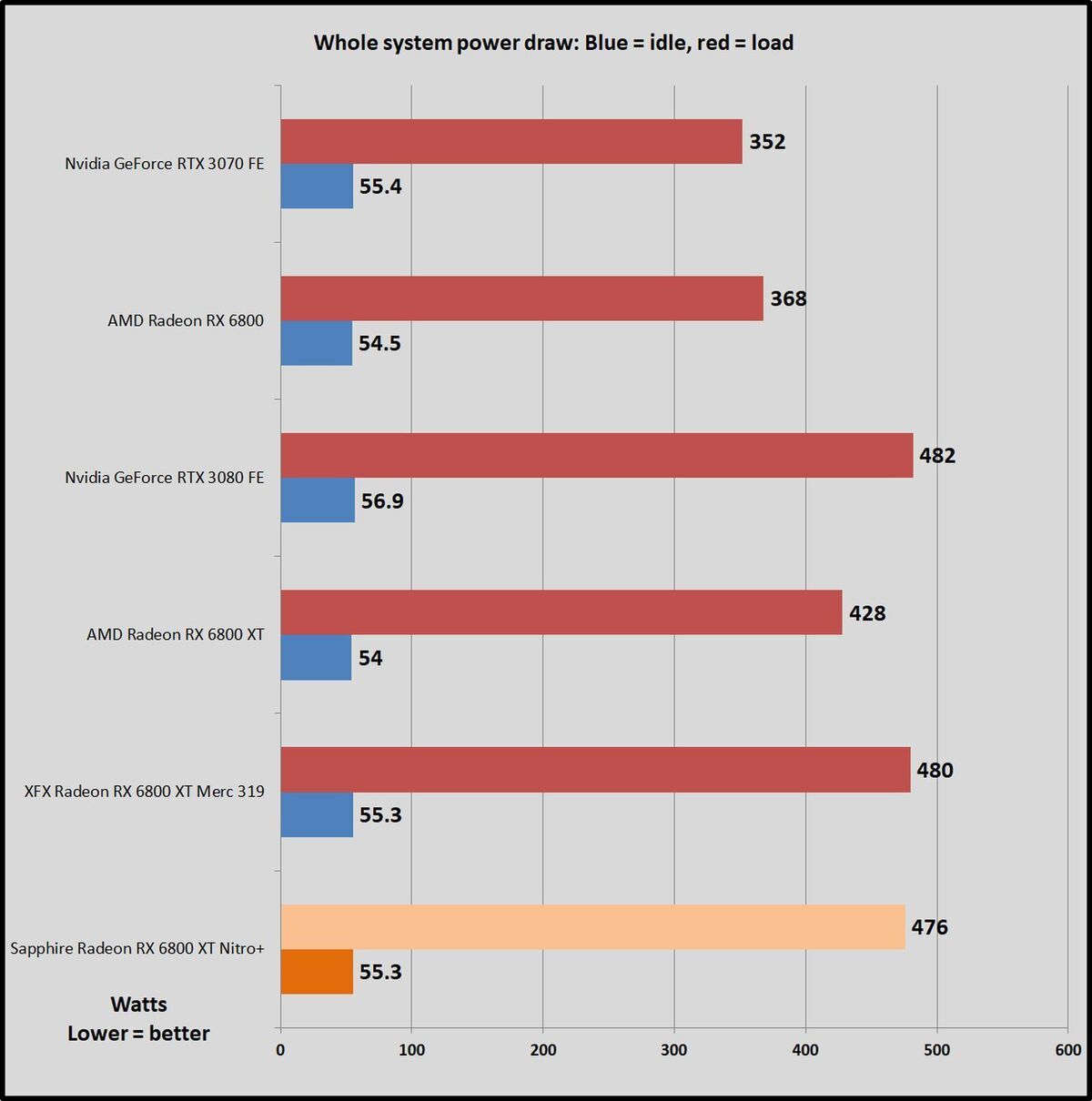 Brad Chacos/IDG
Brad Chacos/IDG The Chromatic Nitro+'s boosted clock speeds and force limit result in a high power quarter than the reference Radeon RX 6800 XT, Eastern Samoa you'd expect. It's connected a par with the similarly overclocked XFX Merc 319 and the RTX 3080 Founders Edition, and information technology draws just about 40W less than overclocked custom RTX 3080s similar the MSI Gaming X Trio and EVGA FTW3 Immoderate.
We test thermals by going away GPU-Z undetermined during theF1 2020power draw try, noting the highest maximum temperature at the closing.
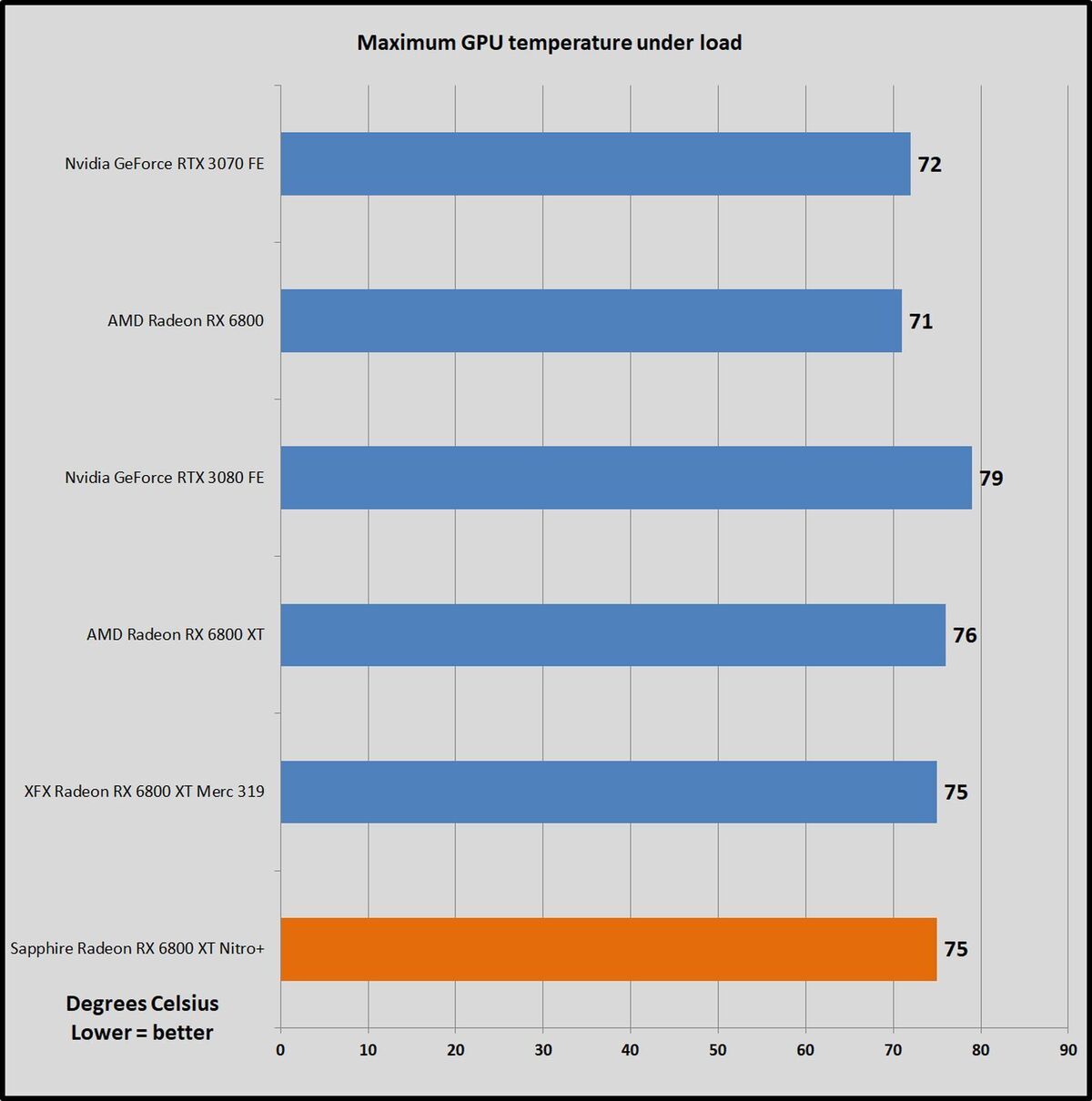 Brad Chacos/IDG
Brad Chacos/IDG Cooling performance is cubic, only not spectacular, with GPU temperatures descending in line with all the nontextual matter card game we've tested therein enthusiast-socio-economic class segment thus far.
It's not shown on this graph, but Lazuline's tweaks help the Nitro+ livelihood the boilersuit GPU computer software much cooler than the source conception. All graphics cards report a core GPU temperature, and that's what we report here. But RDNA-based Radeon graphics cards come through with significantly Thomas More sensors embedded throughout. AMD uses the hottest spot of any of those to adjust clock speeds pro re nata—a metric reported as the "GPU articulation temperature." This hot spot is significantly cooler in Sapphire's nontextual matter card. Spell the reference point AMD Radeon RX 6800 XT hits a 103-degree-Anders Celsius hotspot temp, the Nitro+ tops out at 96 degrees Celsius. (The XFX Merc 319 hit 93 degrees Celsius.)
 Brad Chacos/IDG
Brad Chacos/IDG You can see the wave-shaped heatsink under the Nitro+'s swooping fans.
LET's talk about noise for a second, too. Sky-blue ships the Nitro+ with the Performance BIOS enabled by default. That raises clock and fan speeds to improve gaming frame rates at the expense of higher noise levels. With the Performance BIOS, the Nitro+ remains well unostentatious, but no quieter than AMD's hugely improved reference design. As you stool figure in our gaming benchmarks, however, even the Performance BIOS doesn't get you much extra oomph in raw frame rates.
We highly recommend flipping finished to the Quiet BIOS instead. Information technology's noticeably quieter than the stock setting. Some quick benchmarks revealed you lose a negligible amount of performance even with the lower clocks and fan speeds. IT's a fitter user feel for overall.
With the Quiet BIOS enabled, the Nitro+ doesn't quite match the XFX Merc 319's inaudible running, merely its fan noise is very faint, and XFX's graphics card is one of the most massive we've ever tested.
It's riveting how XFX and Sapphire differed in their BIOS preferences, too. Both offer the exact said speeds on their two BIOS switches, but XFX defaults to the quieter BIOS, while Sapphire opts to get-up-and-go cast rates. The names take issue despite the identical behaviors. Sapphire calls its slower BIOS "Quiet" and defaults to the faster "Performance" BIOS; XFX calls its default slower BIOS "Balanced," and you can flip concluded to the faster "Rage" visibility.
Next page: Should you buy the Sapphire Nitro+ RX 6800 XT?
Should you buy the Sapphire Nitro+ RX 6800 XT?
The Sapphire Nitro+ offers a fine bespoken spin around on AMD's Radeon RX 6800 XT. Information technology's cool, quiet, loaded with a hefty 16GB of memory, and trades blows with Nvidia's touch GeForce RTX 3080 offerings in everything merely ray-traced games. That makes it a compelling pick for 4K and high refresh-grade 1440p gaming, and AMD's architecture pulls ahead of Nvidia's at the lower resolution. (Check out our new AMD Radeon RX 6800-series review for a more comprehensive dislocation of how this GPU stacks up against the RTX 3080.)
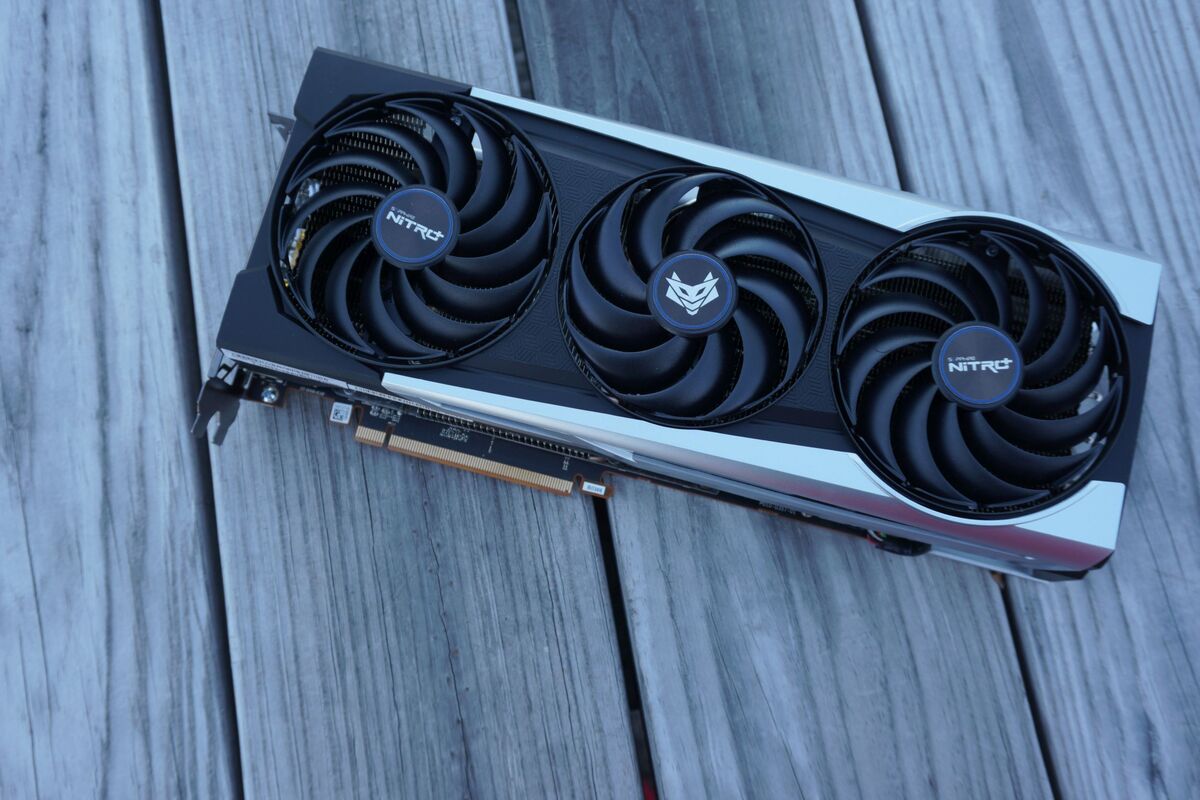 Brad Chacos/IDG
Brad Chacos/IDG Lazuline's innovative Trixx Boost feature article uses intelligent settlement grading paired with AMD's Radeon Image Sampling to campaign performance even further, rental it surpass flatbottom the $1,500 GeForce RTX 3090 in games when enabled. (If you have a Ryzen 5000 processor, AMD's Impertinent Access Memory feature can boost performance even more in some games.) You require to download Sapphire's Trixx utility to use it, and enthusiasts could manage the Saami thing on any graphics card with some tinkering, but Trixx Boost makes it easy. It's a killer feature.
We love the painterly of Sapphire's card, and it weighs significantly less than the entirely-metal designs from XFX and AMD. The backplate's RGB lighting fits nicely, and the dual BIOS switch is always a welcome touch, especially if you plan along using the Nitro+'s beefed-up cooling to push overclocks. Even if you're non, we'd commend flipping away from the default Operation BIOS concluded to the secondary Peaceful BIOS for a punter user experience with skimp carrying into action red. You might likewise prefer the Nitro+'s alternative output signal configuration, which swaps out the reference card's USB-C port for an supernumerary DisplayPort.
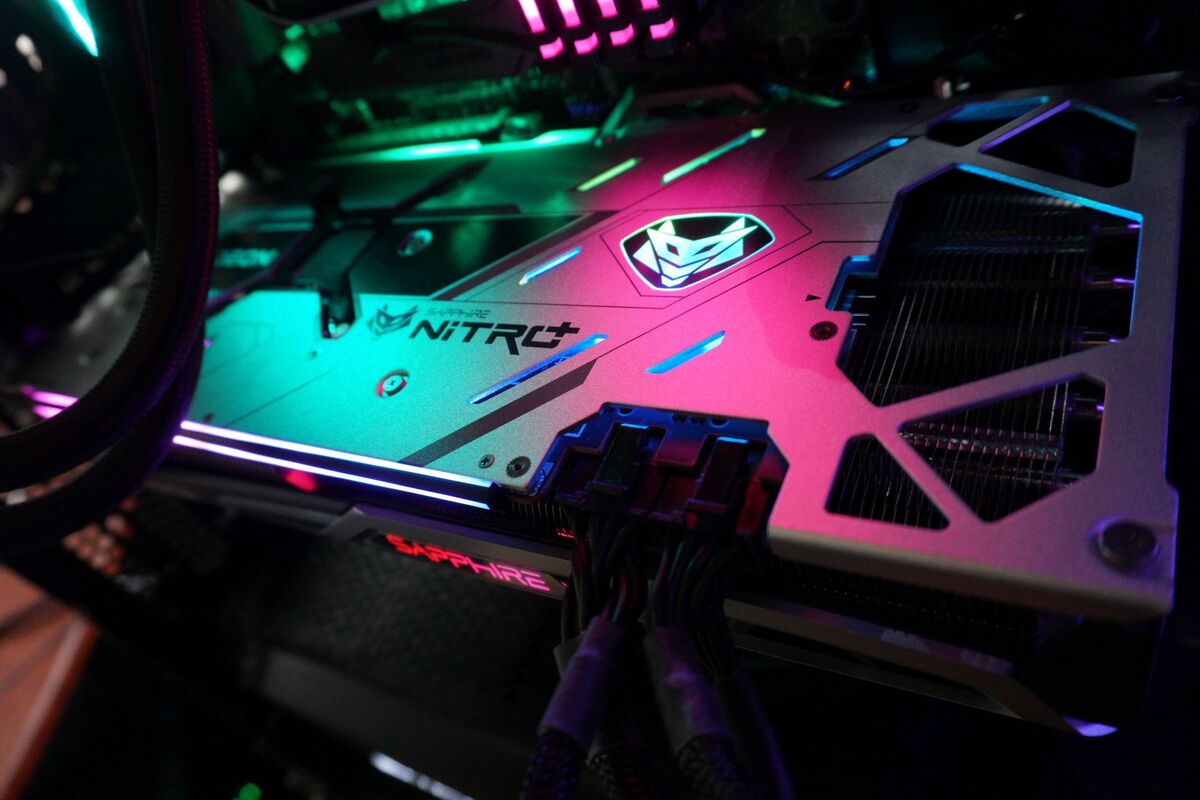 Brad Chacos/IDG
Brad Chacos/IDG Two things prevent us from rating the Nitro+ RX 6800 XT higher and giving IT an Editors' Choice laurels: the price, and the vastly better performance of AMD's Radeon RX 6800 XT reference pattern.
Aesthetics aside, the Azure Nitro+ doesn't offer a tangibly diverse out-of-the-box experience than the extension Radeon RX 6800 XT. Both cards offer virtually identical gaming carrying into action, GPU temperatures, and noise levels (though Sapphire's card keeps components round the GPU tank). Flipping over to the second-string Quiet BIOS makes the Nitro+ whisper-quiet, but not quite an American Samoa inaudible as XFX's gargantuan Merc 319. The reference card's hushed tones will be perfectly bankable to most people.
At $770, the Nitro+ comes in slimly cheaper than some flagship cards we've seen from rival GPU brands, who hold been pushing the well-nig hot-rodded made-to-order RX 6800 XT and RTX 3080 models upward around $800. Still, Sky-blue's gigantic $120 markup over AMD's reference MSRP hurts, and almost completely obliterates the pricing advantage AMD created when it priced the Radeon RX 6800 Crosstalk $50 below the GeForce RTX 3080. Last generation's unflawed Nitro+ Radeon RX 5700 Crosstalk toll only $40 much than the reference 5700 XT and offered often big away-of-the-box benefits.
I get wherefore AMD's hardware partners are pricing their cards thus high. Radeon finally provides competition for Nvidia's enthusiast-class GPUs, and the pandemic has sent the demand for next-gen graphics cards through the roof. Nevertheless, considering how related the out-of-the-package experiences are betwixt the excellent $650 reference card and the $770 Nitro+, people who aren't planning to train advantage of this carte's ad hoc features and don't plan on overclocking should credibly opt for the cheaper model and pocket the extra cash.
 Brad Chacos/IDG
Brad Chacos/IDG Don't get me wrong though: The Sapphire Nitro+ is a fantastic graphics card with top-notch performance, excellent cooling, and a good software put-on. You'll love information technology if you buy IT, specially if you use the Quiet BIOS and reverse on Trixx Boost, or if you'rhenium an overclocking enthusiast. We'd recommend the Nitro+ in a heartbeat if the recommended pricing weren't so unbelievably steep—a concern that also prevented us from awarding the dead-silent, but even more big-ticket XFX Merc 319.
Of course, demand is so high that all adjacent-gen nontextual matter batting order that hits the streets sells out outright, then this hired man-wringing is a bit academic. All we can serve as reviewers is talk about how things should be if stocks became plentiful and scalpers obstructed vendition GPUs for outrageous prices.
Note: When you purchase something subsequently clicking links in our articles, we may pull in a small commission. Read our affiliate link policy for more details.
Source: https://www.pcworld.com/article/393783/sapphire-nitro-radeon-rx-6800-xt-review.html
Posted by: mccallprioner.blogspot.com

0 Response to "Sapphire Nitro+ Radeon RX 6800 XT review: Killer software speeds it up - mccallprioner"
Post a Comment